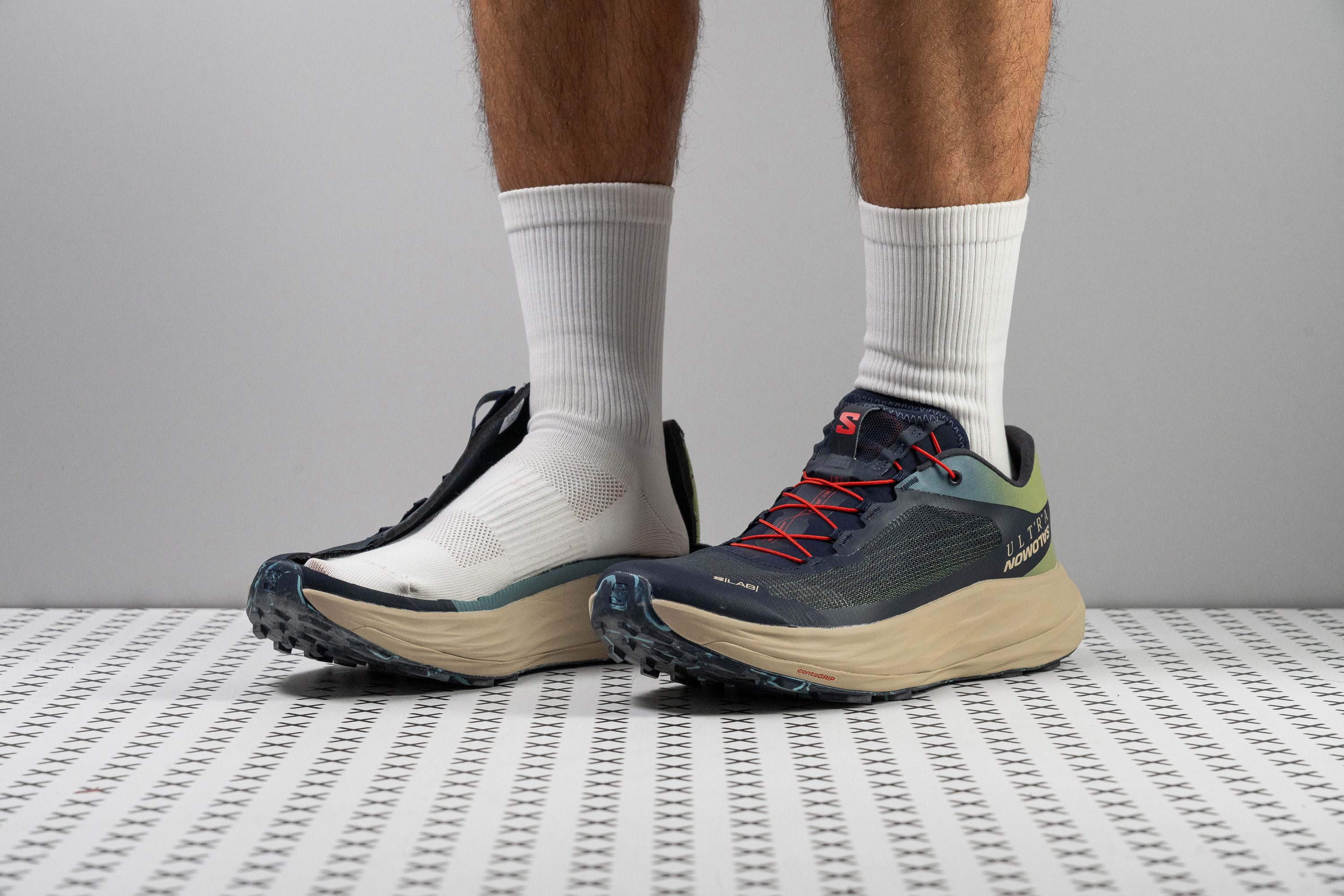Nuestra conclusión
Pros
- Upper MATRYX de primera calidad
- Caucho Contagrip duradero
- Ajuste cómodo y preciso del talón
- Tacos con un diseño versátil
- Rocker en el antepié que te empuja hacia adelante
- Transpirables
- Adecuadas para varias distancias
- El sistema Quicklace hace que te ates los cordones rápido
- Lengüeta bien diseñada
Contras
- Carísimas
- Retorno de energía bajo para su categoría
- Pesadas para ser de competición
- Ajuste extremadamente ceñido
Veredicto de los usuarios
Comparativa
Las zapatillas de running más parecidas
+ + Añadir unas zapatillas | |||||
|---|---|---|---|---|---|
| Puntuación global | 82 Buenas | 90 Excelentes | 89 Notables | 88 Notables | |
| Precio | 240 € | 140 € | 150 € | 180 € | |
| Terreno de trail | SencilloModerado | Sencillo | SencilloModerado | ModeradoTécnico | |
| Arch support | Neutral | Neutral | Neutral | Neutral | |
| Peso laboratorio Peso marca | 10.2 oz / 290g 10.3 oz / 293g | 9.7 oz / 275g 10.8 oz / 307g | 10.9 oz / 309g 10.9 oz / 309g | 10.3 oz / 293g 10.4 oz / 295g | |
| Drop laboratorio Drop marca | 10.2 mm 8.0 mm | 11.6 mm 6.0 mm | 8.8 mm 6.0 mm | 7.2 mm 4.0 mm | |
| Técnica de carrera | Talón | Talón | TalónMedio/antepié | Medio/antepié | |
| Talla | - | Tallan bien | Tallan bien | Tallan bien | |
| Rigidez de la mediasuela | Blanda | Equilibrada | Blanda | Blanda | |
| Diferencia de la rigidez de la mediasuela en frío | Normal | Normal | Grande | Normal | |
| Durabilidad de la parte delantera | Mala | Buena | Mala | Buena | |
| Durabilidad del acolchado del talón | Alta | Alta | Alta | Alta | |
| Durabilidad de la suela exterior | Buena | Buena | Decente | Buena | |
| Transpirabilidad | Media | Baja | Media | Media | |
| Anchura / ajuste | Estrecha | Media | Media | Media | |
| Anchura de la parte delantera | Estrecha | Media | Media | Estrecha | |
| Flexibilidad | Moderada | Moderada | Moderada | Moderada | |
| Rigidez torsional | Rígidas | Rígidas | Rígidas | Rígidas | |
| Rigidez del contrafuerte del talón | Flexible | Rígido | Rígido | Flexible | |
| Profundidad del dibujo de la suela | 3.5 mm | 3.3 mm | 3.6 mm | 3.9 mm | |
| Altura de la suela en la zona del talón laboratorio Altura de la suela en la zona del talón marca | 36.3 mm 40.0 mm | 35.8 mm 30.0 mm | 36.7 mm 39.0 mm | 38.0 mm 33.0 mm | |
| Antepié laboratorio Antepié marca | 26.1 mm 32.0 mm | 24.2 mm 24.0 mm | 27.9 mm 33.0 mm | 30.8 mm 29.0 mm | |
| Anchuras disponibles | Estándar | Estándar | Estándar | Estándar | |
| Estación | Todas las estaciones | Todas las estaciones | Todas las estaciones | Todas las estaciones | |
| Removable insole | ✓ | ✓ | ✓ | ✓ | |
| Orthotic friendly | ✓ | ✓ | ✓ | ✓ | |
| Clasificación | #274 25% inferior | #48 Top 14% | #89 Top 25% | #131 Top 36% | |
| Popularidad | #353 4% inferior | #191 48% inferior | #171 Top 47% | #83 Top 23% |
Who should buy
In our view, the Salomon S/Lab Ultra is a great match for:
- Trail runners loyal to the Salomon brand who don’t mind paying a premium for the S/Lab experience.
- Those with narrow feet seeking a reliable shoe that offers a secure fit for trail running or hiking.
- Fans of the MATRYX upper who value its top-tier tech and precision feel, even at the expense of affordability.
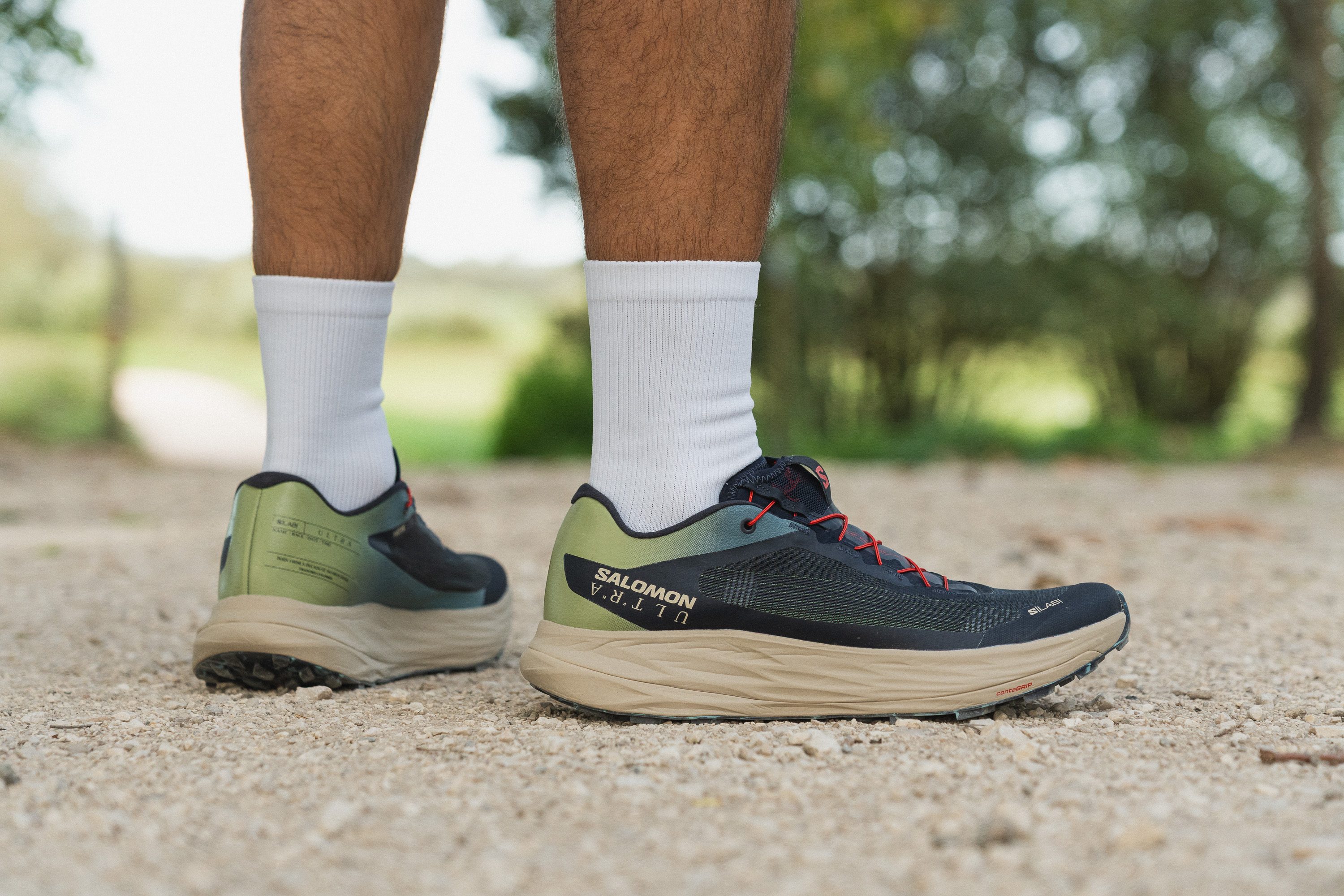
Who should NOT buy
We believe that the Salomon S/Lab Ultra isn’t the best choice for most runners. Its snug fit can feel overly restrictive, even for those with average-width feet, limiting natural toe splay and overall comfort. In our lab, we found that the Nike Zegama 2 provides a more relaxed fit, better toe space, and even superior energy return... all for a lower price!
Additionally, we think the S/Lab Ultra’s energy return falls far short of expectations for such a premium price tag. Based on our lab measurements, the rebound is just average. If you’re seeking an energetic trail shoe, we recommend the Hoka Tecton X 3 or Adidas Terrex Agravic Speed Ultra instead.
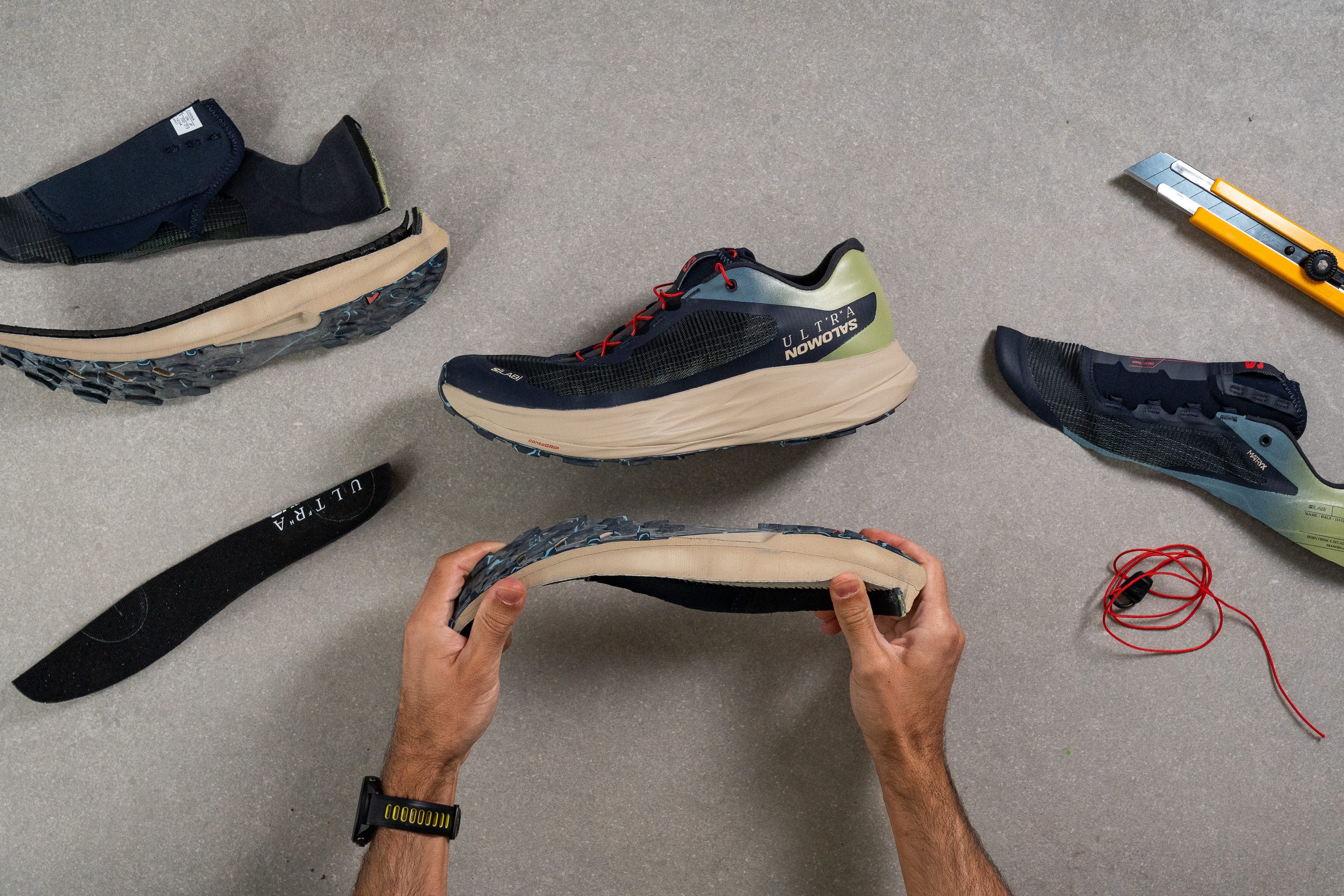
Amortiguación
Shock absorption
We found that the S/Lab Ultra absorbs impact far better at the heel than at the forefoot.
During testing, it reached 130 SA in the rear, while the front registered only 95 SA. This is a noticeable difference that gives the shoe a distinctly heel-striker-friendly character. Or makes it a great choice for runners who like a forefoot that slightly cushions impact but feels natural underfoot.
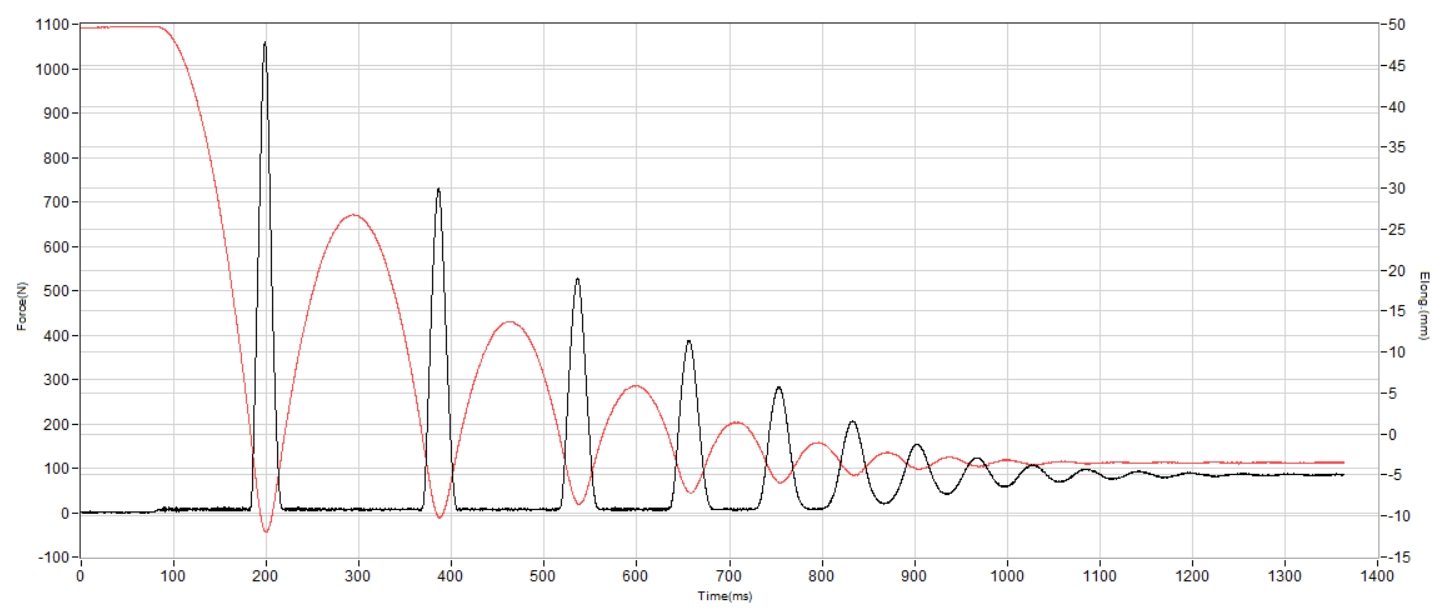
| S/Lab Ultra | 130 SA |
| Media | 122 SA |
Energy return
We found in our lab tests that the Ultra’s energy return fell short of what we expected for a competition shoe.
The foam produced only 55.4% rebound in the heel and a slightly higher 59.8% in the forefoot—both sitting in the average range at best. These numbers reveal a low-bounce performance that fails to justify its high-end price tag, and we think that results should have reached the 65-70% zone.
| S/Lab Ultra | 56.4% |
| Media | 55.6% |
Altura de la suela en la zona del talón
The heel stack lives up to its “Ultra” name, standing well above average at 36.3 mm, which makes it ideal for heel strikers seeking extra cushioning on each landing.
We also appreciate how it strikes an interesting balance by offering solid shock absorption without exceeding 40 mm of total height, where stability often starts to suffer.
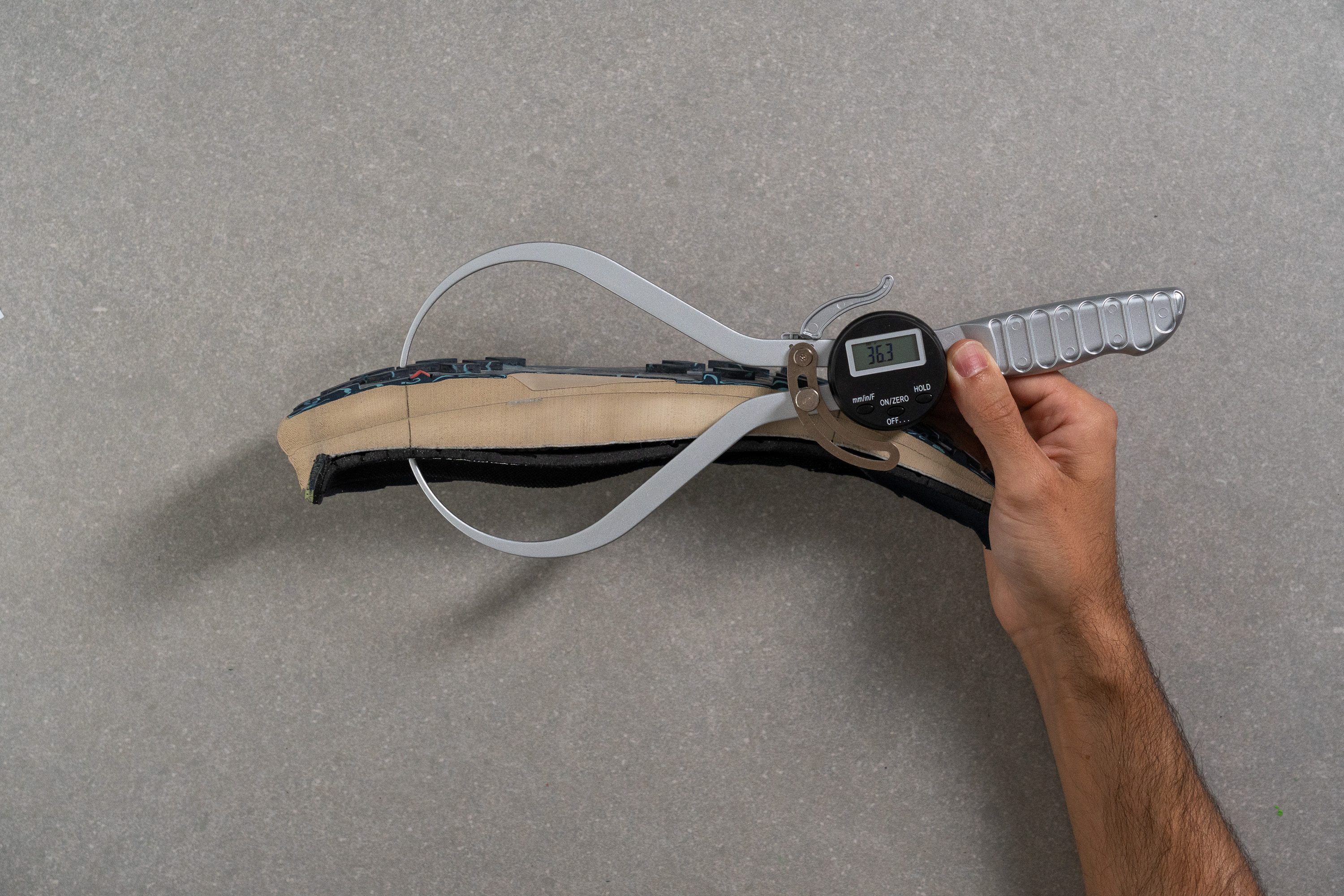
| S/Lab Ultra | 36.3 mm |
| Media | 32.6 mm |
Altura de la suela en el antepié
Our digital calipers measured the forefoot stack of the S/Lab Ultra at 26.1 mm. While this doesn’t qualify it as a maximalist shoe like the ASICS Trabuco Max 4, it’s slightly higher than most trail models.
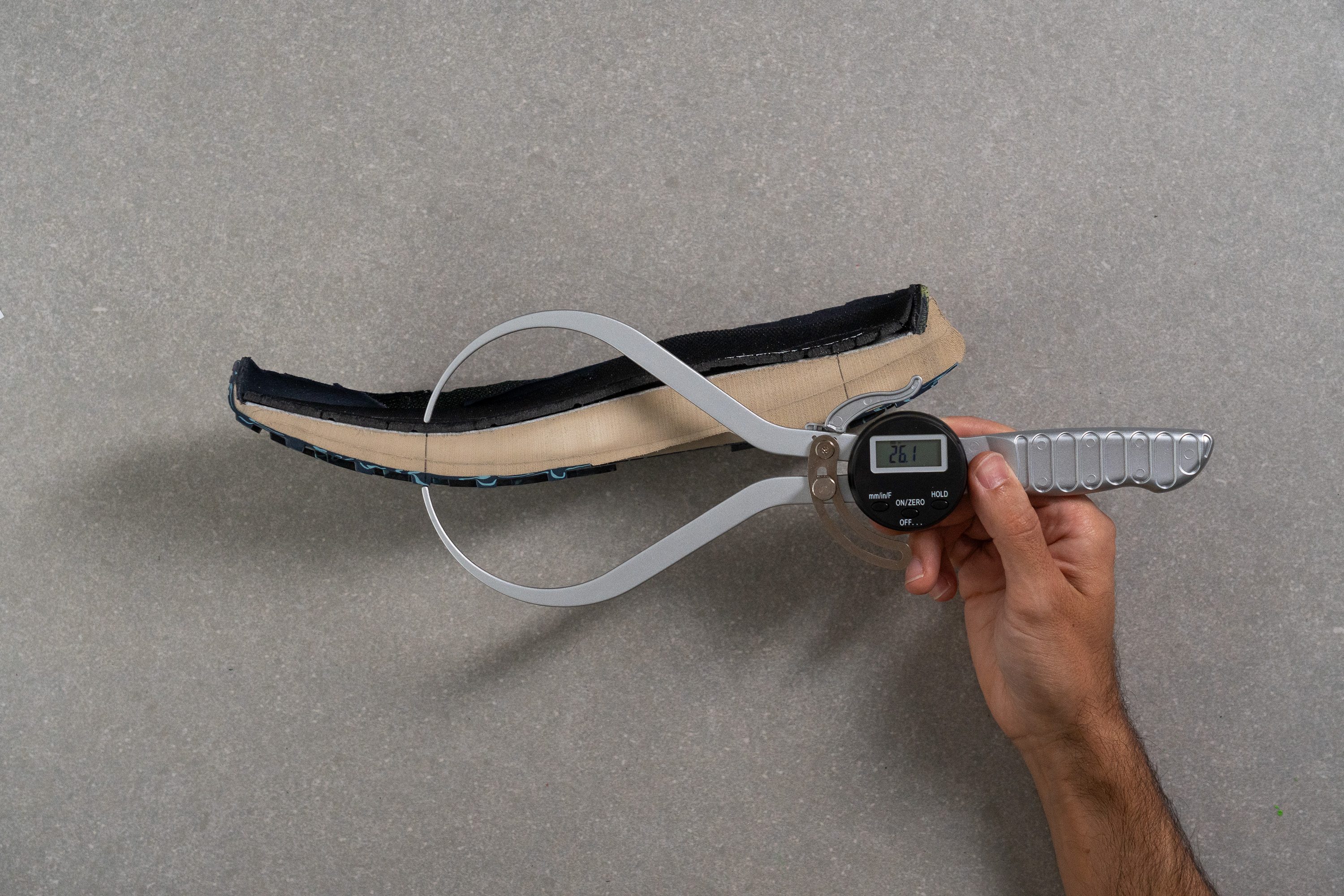
| S/Lab Ultra | 26.1 mm |
| Media | 25.1 mm |
Drop
We measured a 10.2 mm heel-to-toe drop. Sure, it's uncommon for a trail shoe, though not far from Salomon’s stated 8 mm. In our view, this midsole design is another clear nod to heel strikers and those running long distances, as form usually suffers after 2-3 hours and everyone starts to heel strike.
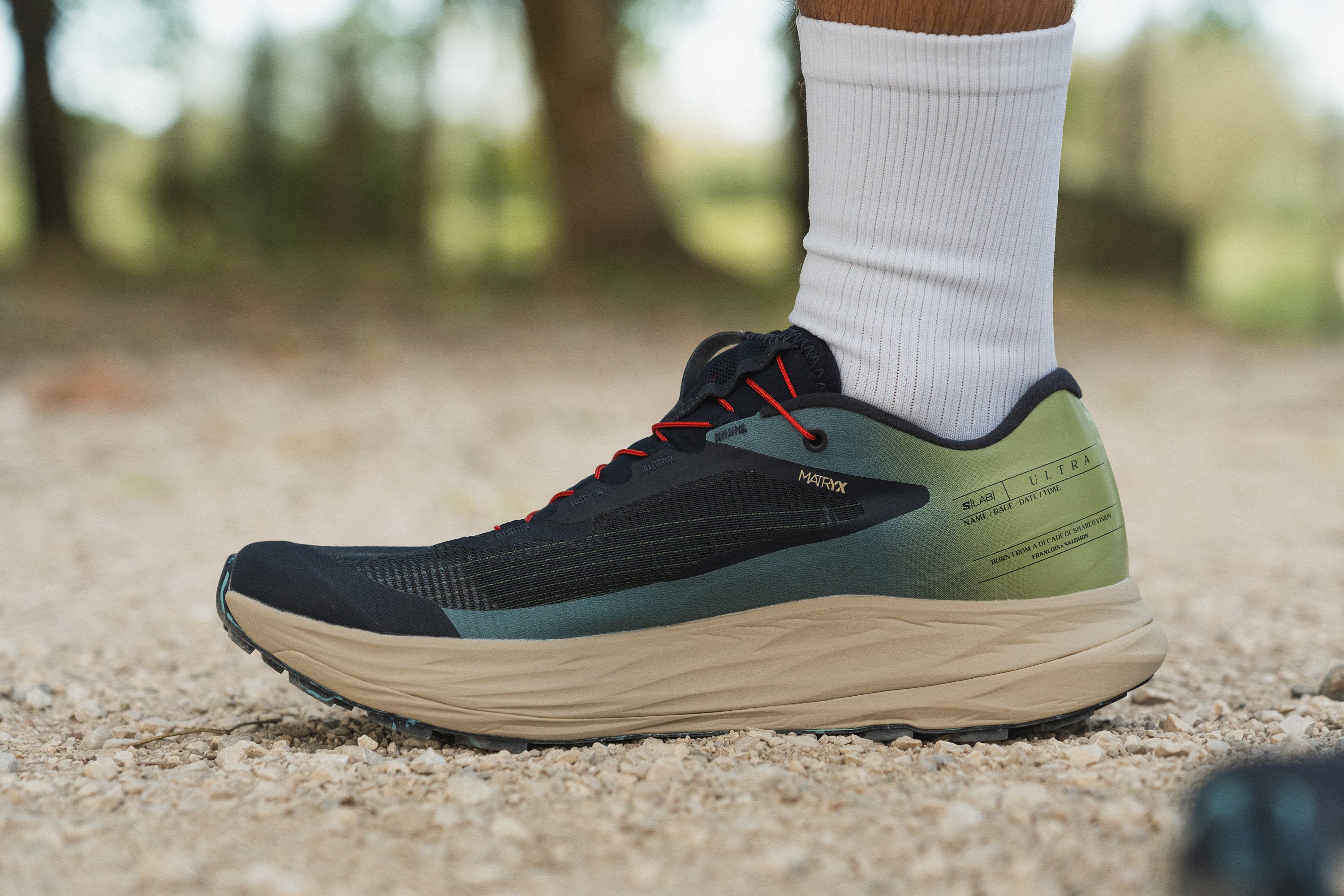
| S/Lab Ultra | 10.2 mm |
| Media | 7.6 mm |
Suavidad de la mediasuela
The Energy Foam midsole feels slightly softer than most trail models, a sensation we confirmed with our Shore A durometer, which measured 17.5 HA.
However, as with all trail shoes, the lugs naturally firm up the ride compared to a road shoe with the same reading, so keep that in mind when expecting certain underfoot feel.
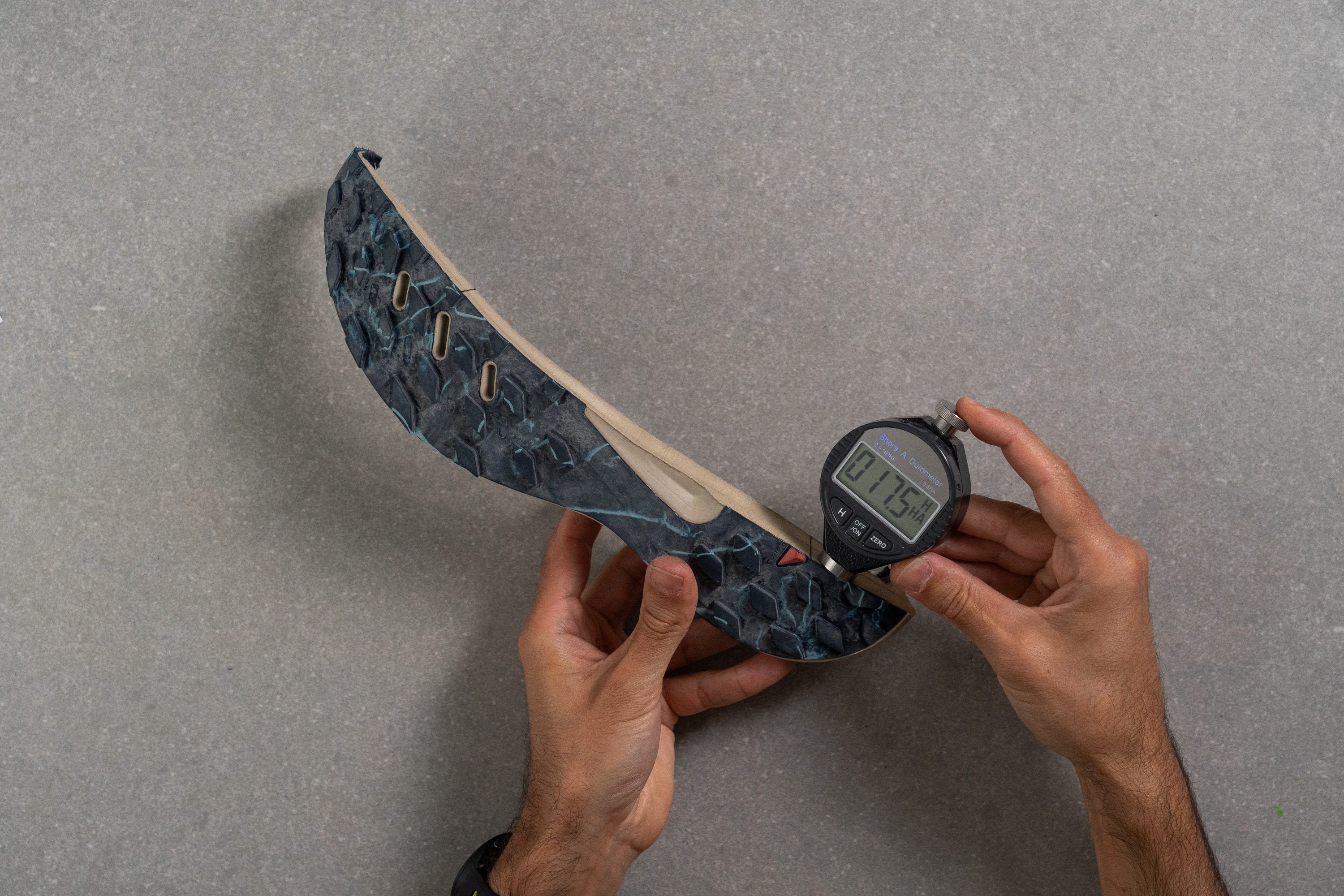
| S/Lab Ultra | 17.5 HA |
| Media | 21.9 HA |
Rocker
The S/Lab Ultra shows a pronounced forefoot rocker for a trail shoe, with noticeable curvature in both the heel and forefoot. This design encourages a smoother forward roll and helps maintain momentum during long runs and ultra events.
We also found that the heel’s rounded shape also eases landings for rearfoot strikers.
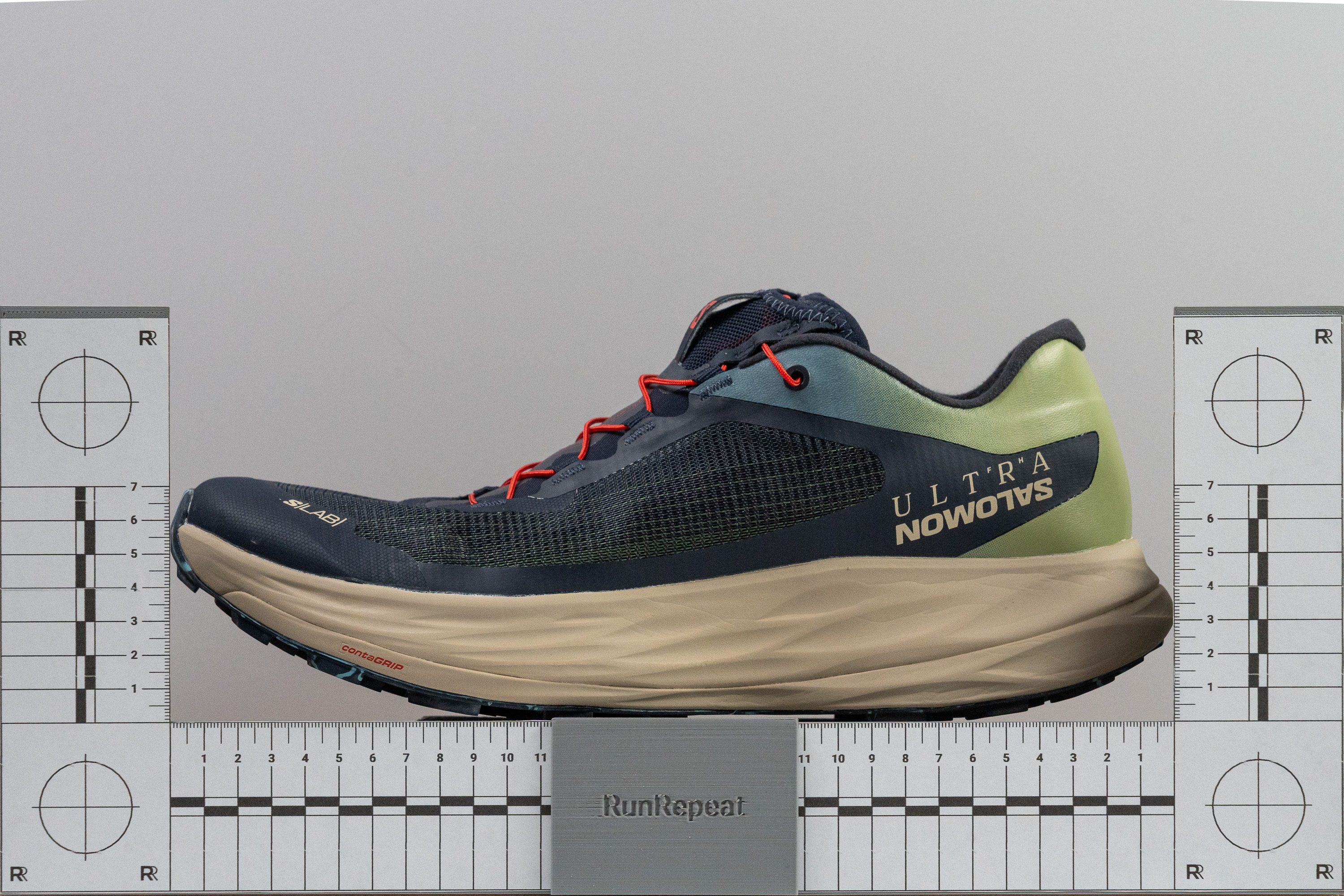
Placa
The S/Lab Ultra uses a fiberglass profeelPLATE with an X-shaped design, which is why it’s barely visible in our cut-in-half shoe. It extends along the sides toward the forefoot and heel, acting as a rock plate and also adding stability.
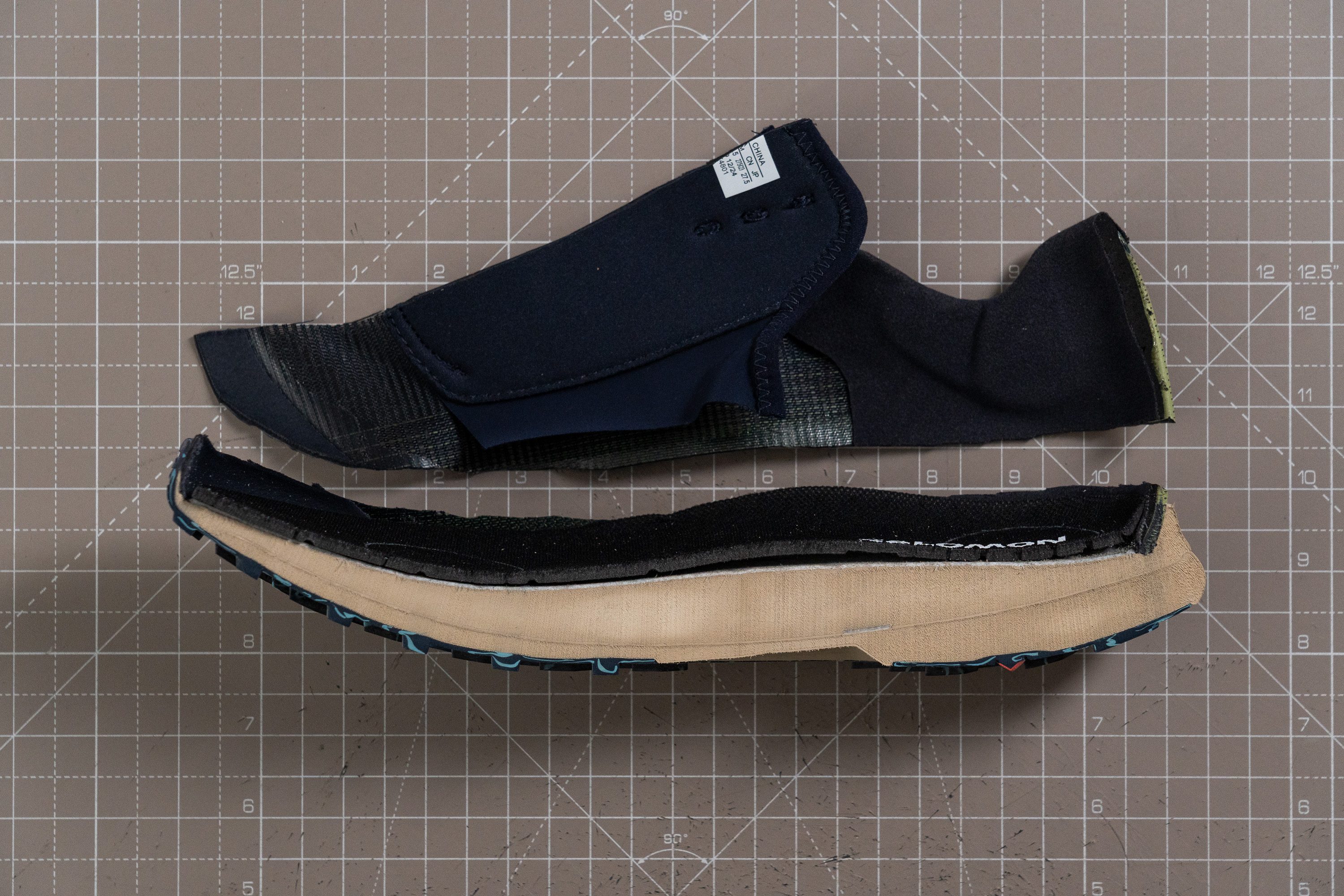
Tallaje y ajuste
Talla
Anchura / Ajuste
When we tested the S/Lab Ultra, they immediately felt tighter than the S/Lab Genesis we examined some days ago, so we wanted to verify that with real data from our gel-based replica of the interior of the shoe.
Our measurement showed 91.3 mm in width, a clearly snug fit. This narrow design is quite common for Salomon’s S/Lab line, so discovering a wide, comfort-oriented fit would’ve been the real surprise.
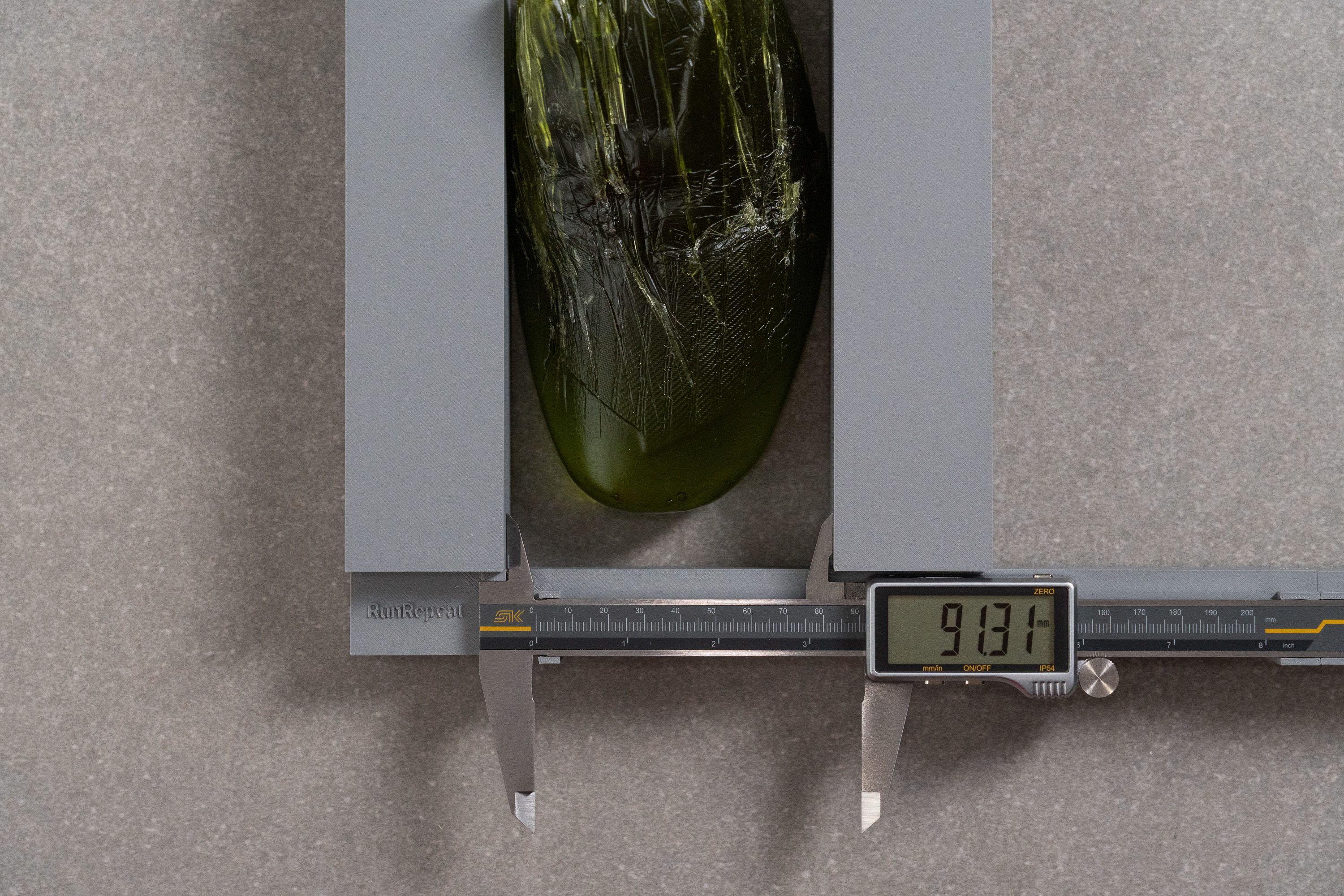
| S/Lab Ultra | 91.3 mm |
| Media | 95.6 mm |
Anchura de la parte delantera
Our second measurement came in at just 67.1 mm in the toebox.
In our experience, that's an extremely snug setup made for runners who enjoy a glove-like fit that maximizes security during fast turns and quick movements but restricts toe splay, making it unsuitable for wide feet.
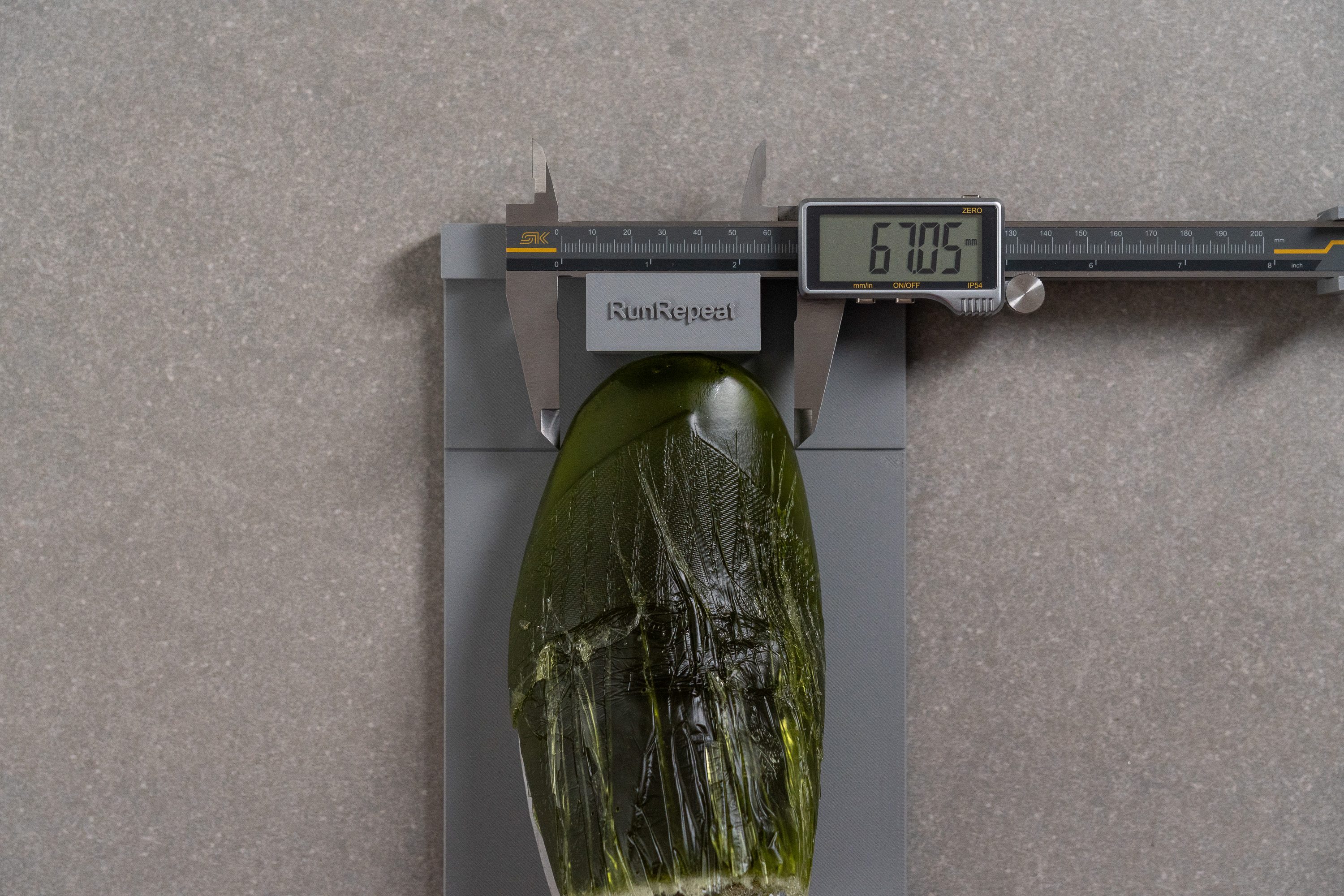
| S/Lab Ultra | 67.1 mm |
| Media | 74.6 mm |
Altura de la parte delantera
To complete the hat-trick of snug readings, the final measurement also delivered what tight-fit fans expect.
We recorded 24.4 mm—well below our lab’s current average and clearly intended for runners who prefer minimal interior space.
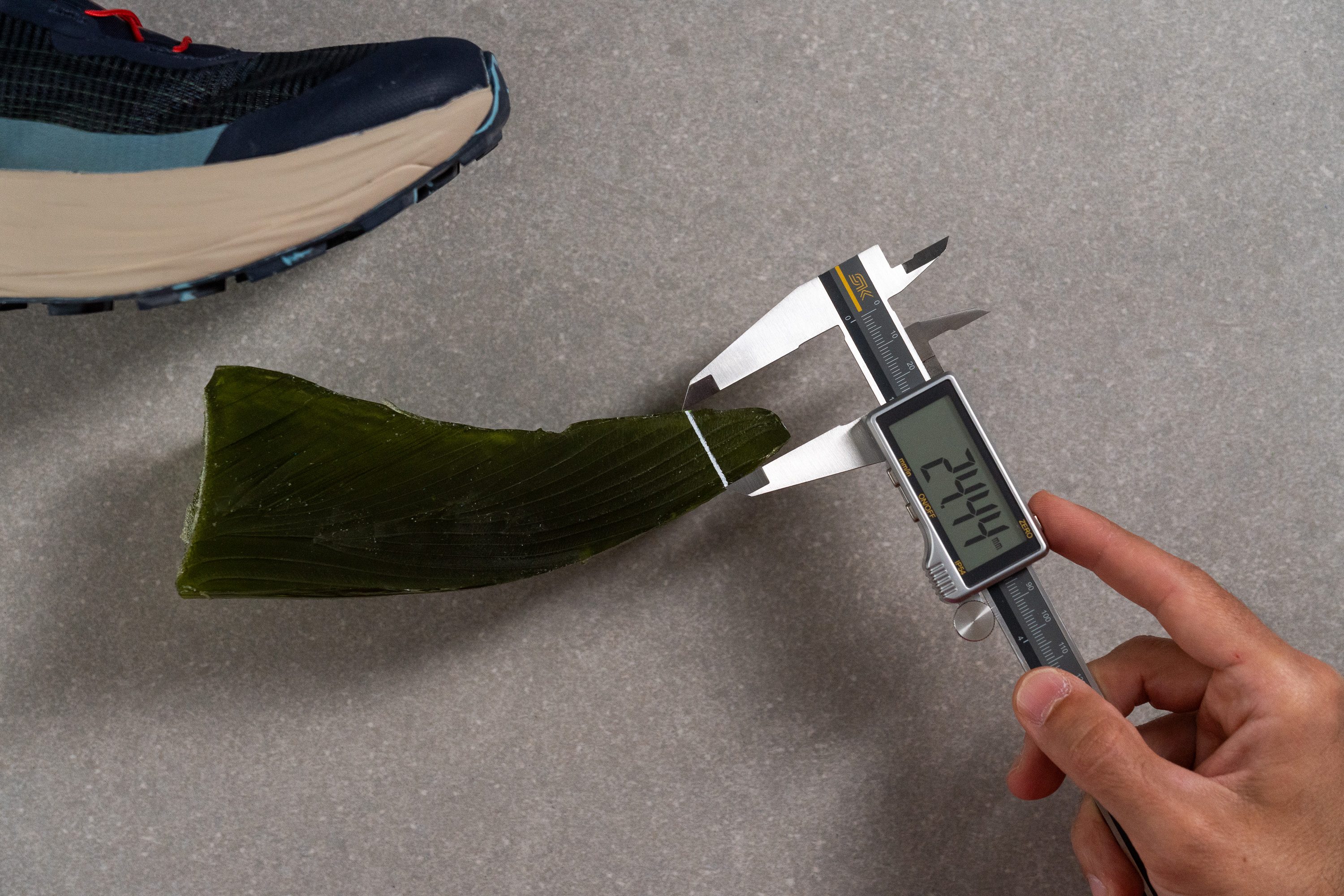
| S/Lab Ultra | 24.4 mm |
| Media | 27.0 mm |
Tracción / Agarre
Tracción en el antepié
We found in our SATRA TM144 test that Salomon’s Contagrip rubber performed well, landing a 0.54 score. It’s not a sky-high number, but it’s a solid result for a shoe that isn’t built for technical terrain.
| S/Lab Ultra | 0.54 |
| Media | 0.60 |
Profundidad del dibujo de la suela
Salomon played it safe with the S/Lab Ultra’s outsole, opting for versatile, mid-depth 3.5 mm lugs. Their angular layout provides solid traction on mixed terrain.
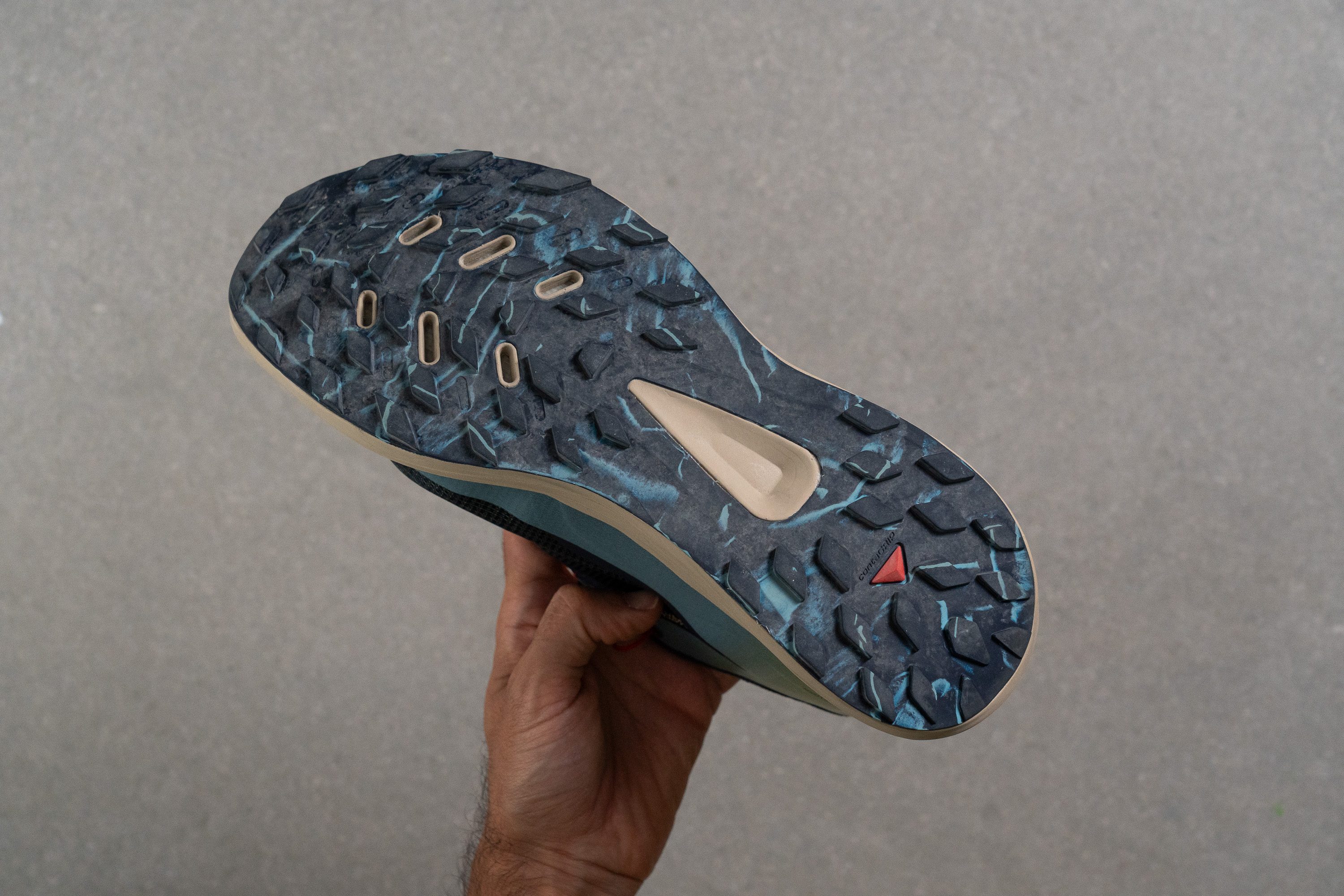
In our view, this setup isn’t ideal for very technical or muddy conditions, as the higher lug density and reduced spacing favor grip on dry, stable surfaces.
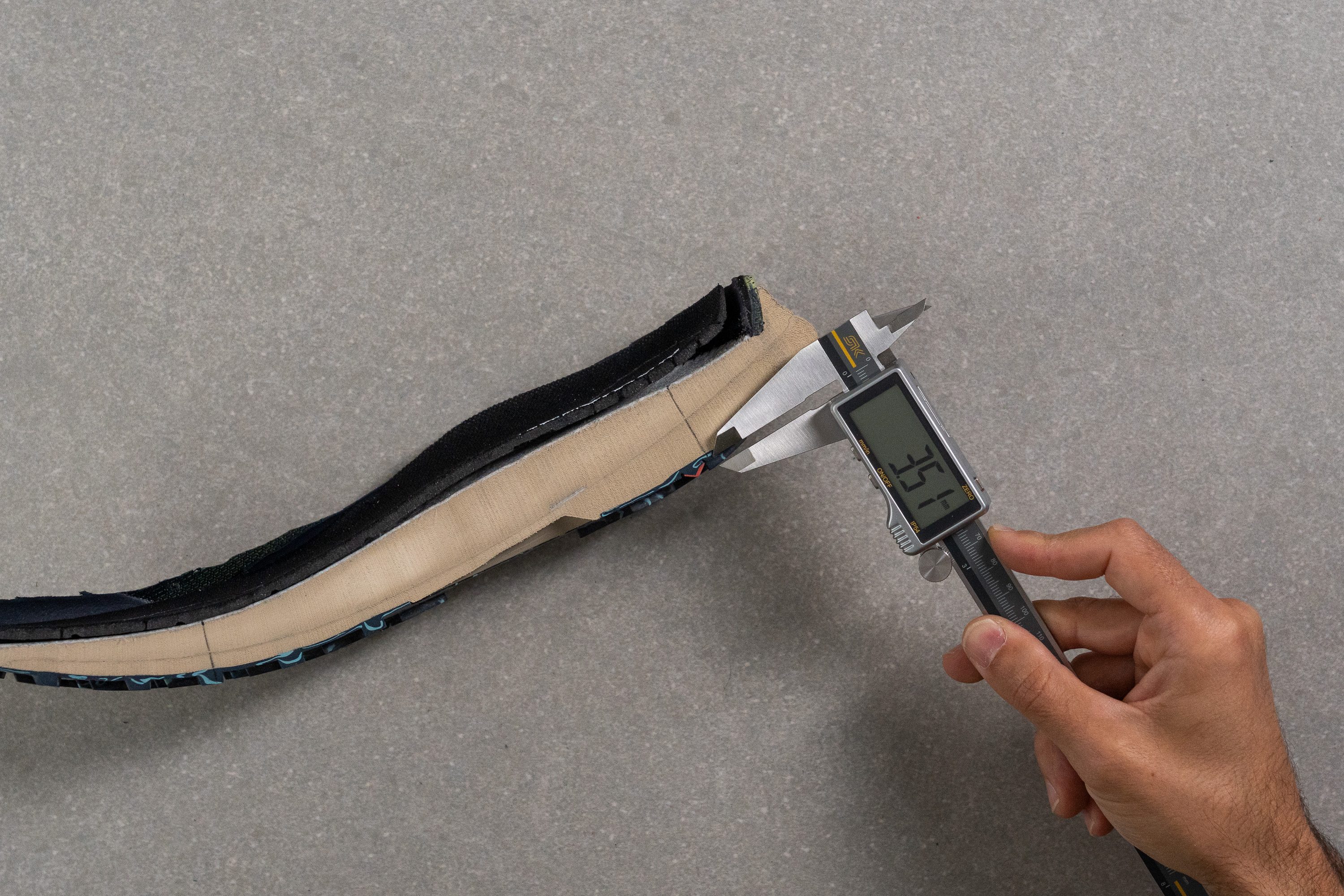
| S/Lab Ultra | 3.5 mm |
| Media | 3.5 mm |
Diseño de la suela exterior
The outsole uses Salomon’s Contagrip rubber combined with exposed midsole foam in the center to reduce weight. We appreciated the almost full rubber coverage, with only a small midfoot cutout designed to trim excess material without compromising durability.
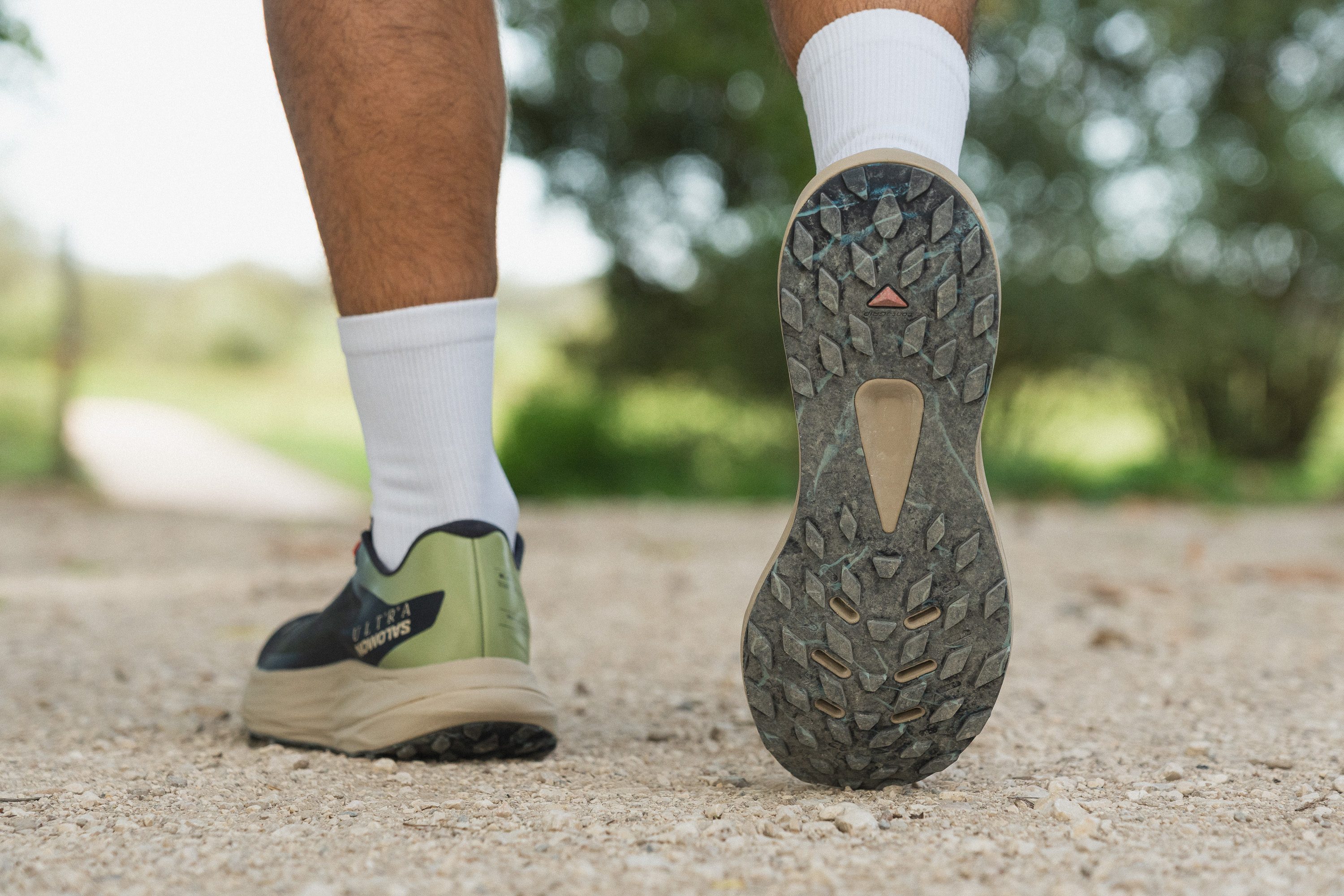
Flexibilidad / Rigidez
The higher-than-average stack height, full rubber coverage without horizontal cutouts, and fiberglass plate combine to raise stiffness to 16.1N in our 30-degree test. This makes the shoe less flexible than most, yet still more forgiving than many carbon-plated models.
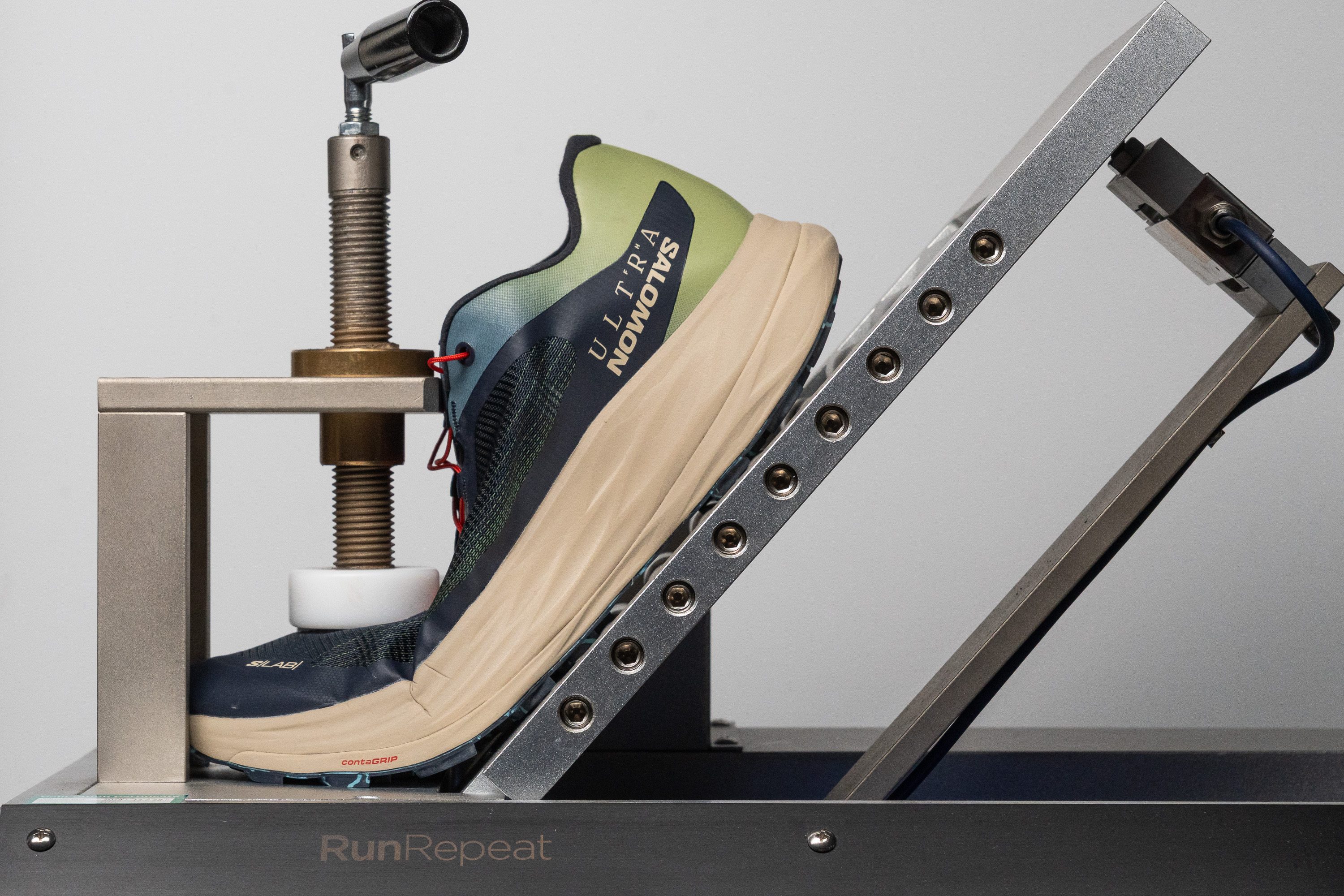
| S/Lab Ultra | 16.1N |
| Media | 14.6N |
Peso
One of the most disappointing findings in our tests was the shoe’s high weight. At 10.2 oz (290g), it sits above what we’d expect for a competition-focused model. While this might sound like an average figure, we think it's heavy for race use.
Most rivals in this price range manage to weigh less while offering more cushioning through premium foams. For us, the main issue here is clear: Salomon needs to switch to a lighter, supercritical foam as soon as possible.
| S/Lab Ultra | 10.2 oz (290g) |
| Media | 10.2 oz (289g) |
Transpirabilidad
As expected from an S/Lab premium model, the MATRYX upper made by Chamatex Group in France delivers outstanding quality.
In our breathability test, it scored 4/5. That's a very good result for a trail shoe, providing strong airflow in summer while offering solid protection in colder conditions.
Moving the upper over our light, we identified two distinct zones: a razor-thin toebox designed for maximum ventilation and a more structured midfoot and heel that provide enhanced support and a secure, locked-in fit.
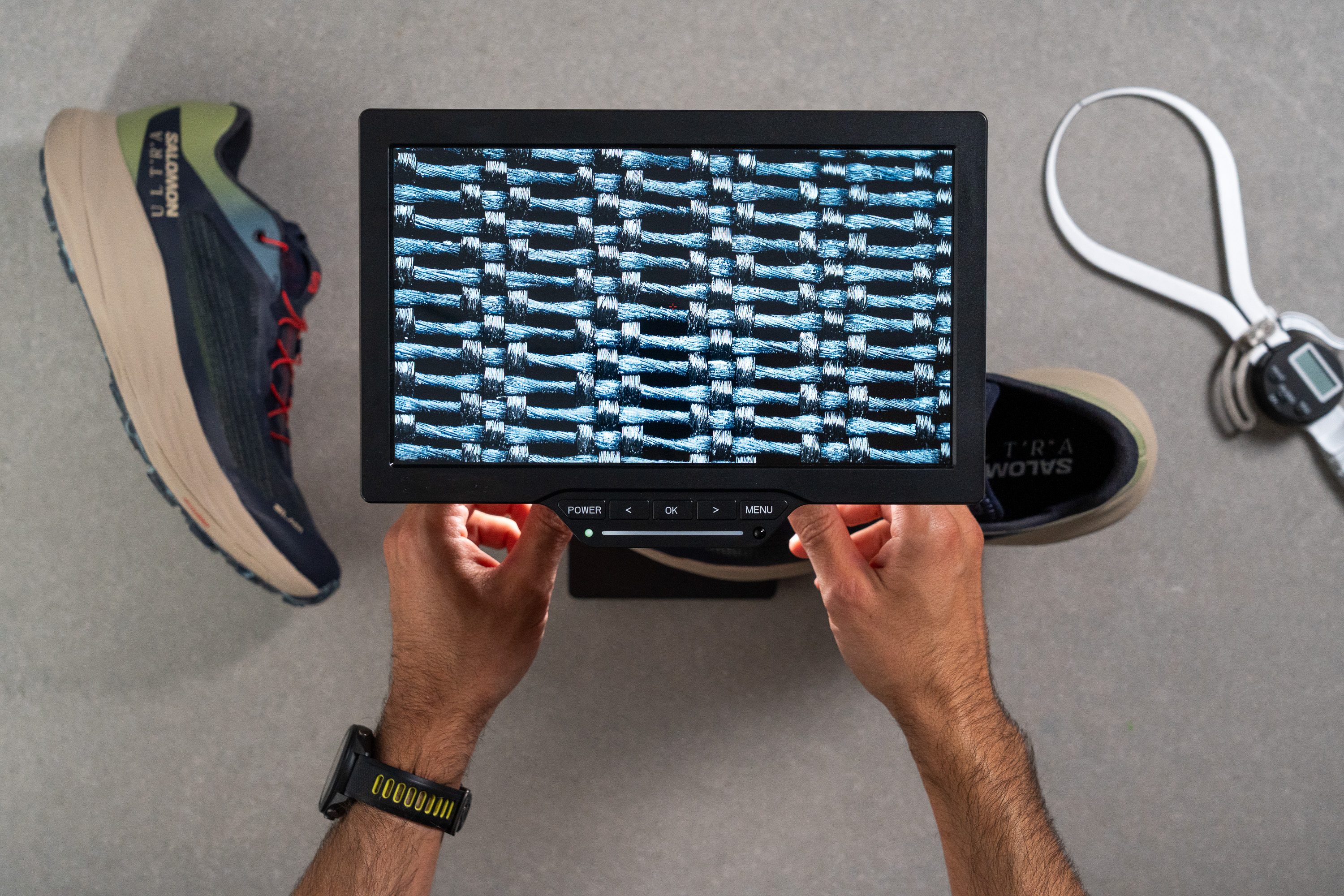
The MATRYX fabric blends Kevlar yarns to improve durability. We'll find in this same review if that's true!
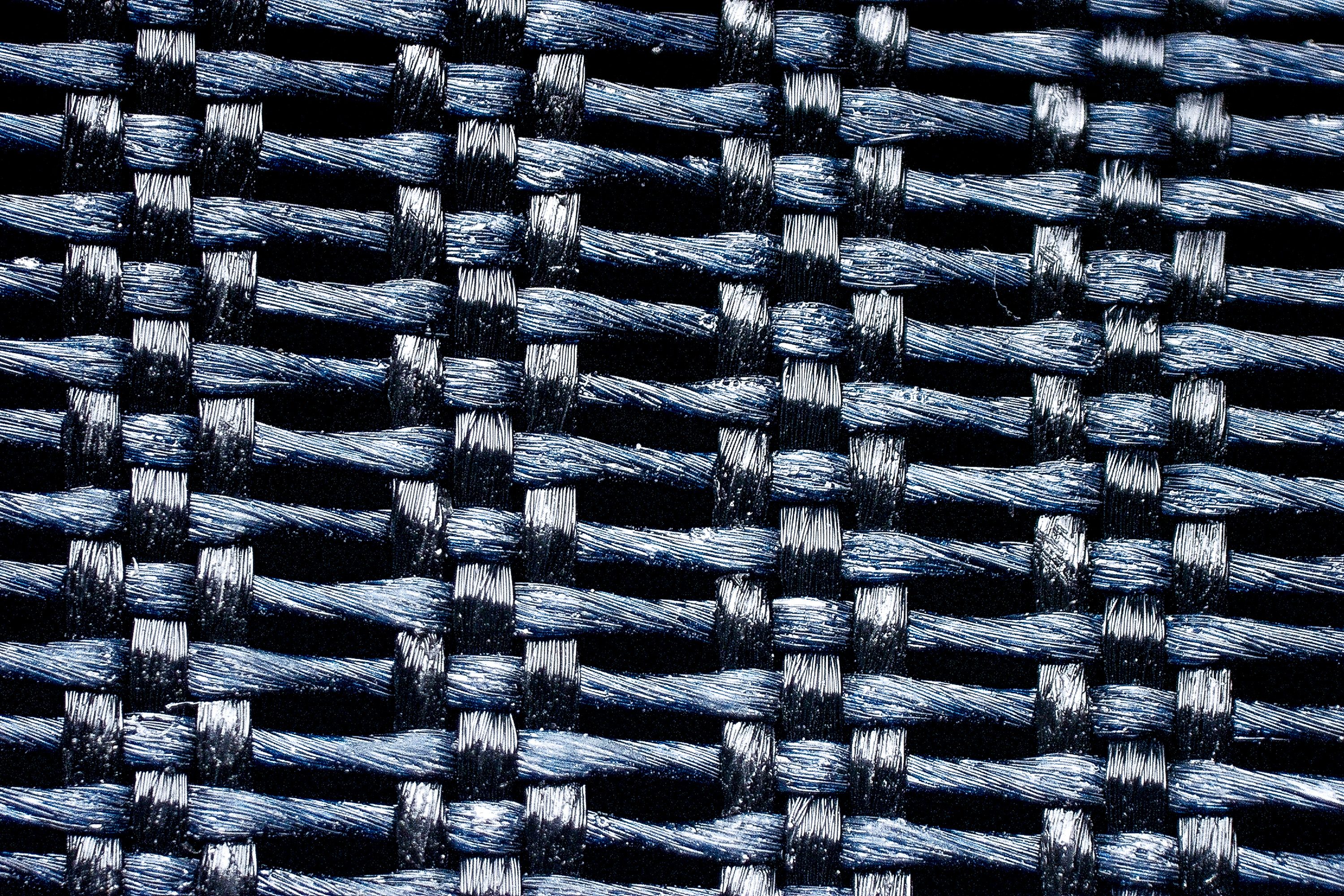
When it comes to comfort, the upper truly performs. There’s generous padding throughout the shoe, and it’s clear that Salomon intentionally traded a touch of performance for a more cushioned feel.
| S/Lab Ultra | 4 |
| Media | 3.2 |
Estabilidad
Prueba de estabilidad lateral
We wouldn’t describe this shoe as "stable," mainly because it lacks supportive features and its platform isn’t particularly wide. However, this shoe has a clever trick: the ultra-snug fit offers just enough hold for runners who need a slight touch of support, and it’s definitely noticeable especially when taking fast corners.
Rigidez torsional
With a fiberglass plate embedded in the midsole and full-length rubber coverage, the Ultra is nearly impossible to twist, earning a 5/5 in our torsional rigidity test.
| S/Lab Ultra | 5 |
| Media | 3.6 |
Rigidez del contrafuerte del talón
The heel counter is on the opposite end of the spectrum. Rather than using a firm structure, it easily conforms to the foot, offering minimal support but excellent comfort. We rated it 2/5.
| S/Lab Ultra | 2 |
| Media | 3 |
Anchura de la mediasuela - antepié
The shoe isn’t maximalist in either height or width, and its proportions feel closer to a daily trainer. That makes sense, as Salomon athletes like Kilian Jornet—before leaving to start NNormal—often favored thinner midsoles and lower-cushioned, narrow shoes even for crazy-long ultra races.
In this case, we measured 115.1 mm, just slightly above the average for trail shoes.
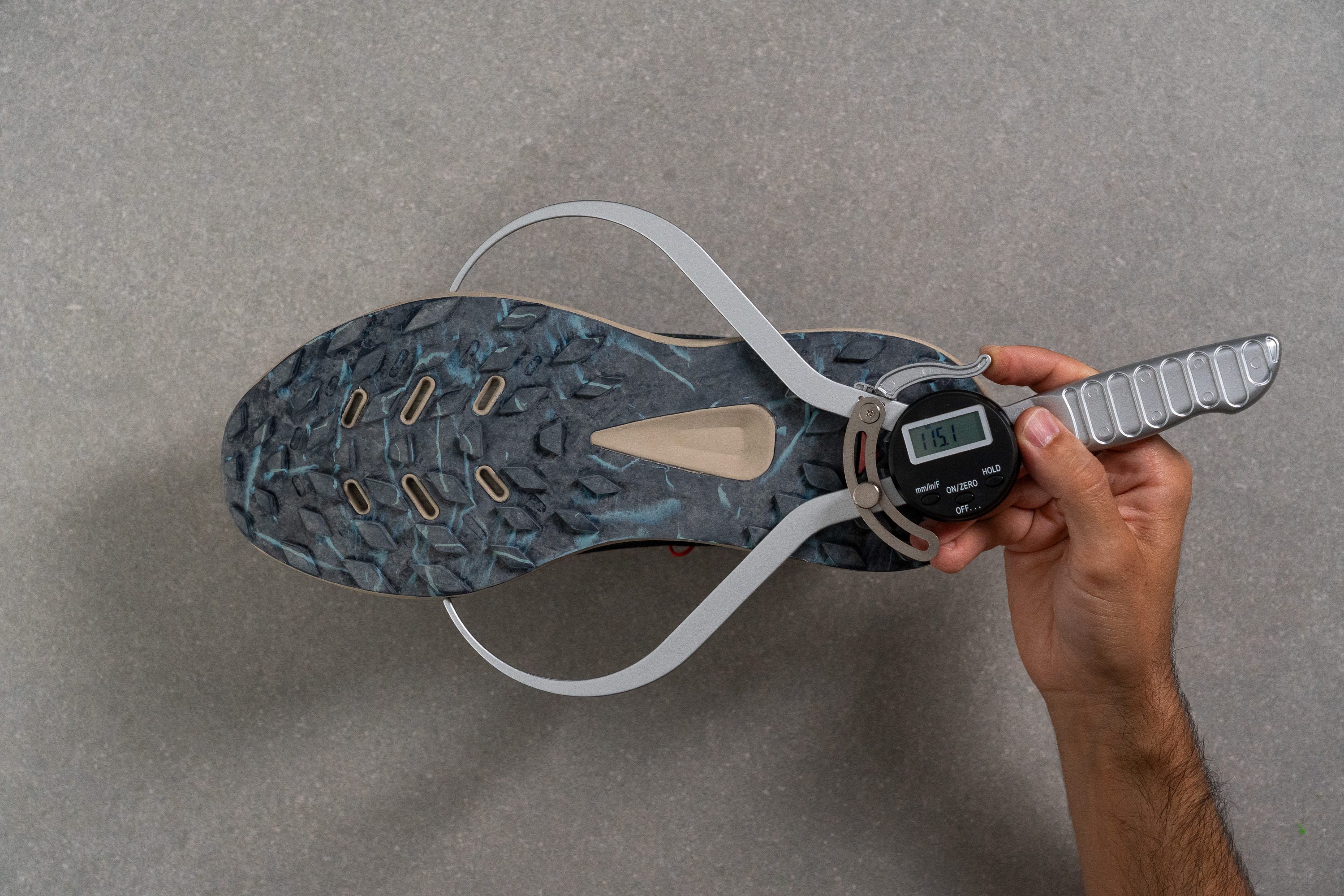
| S/Lab Ultra | 115.1 mm |
| Media | 112.8 mm |
Anchura de la mediasuela - talón
The heel follows the same approach, measuring 91.8 mm. There’s not much added support here, but it keeps the Ultra feeling agile and never bulky underfoot.
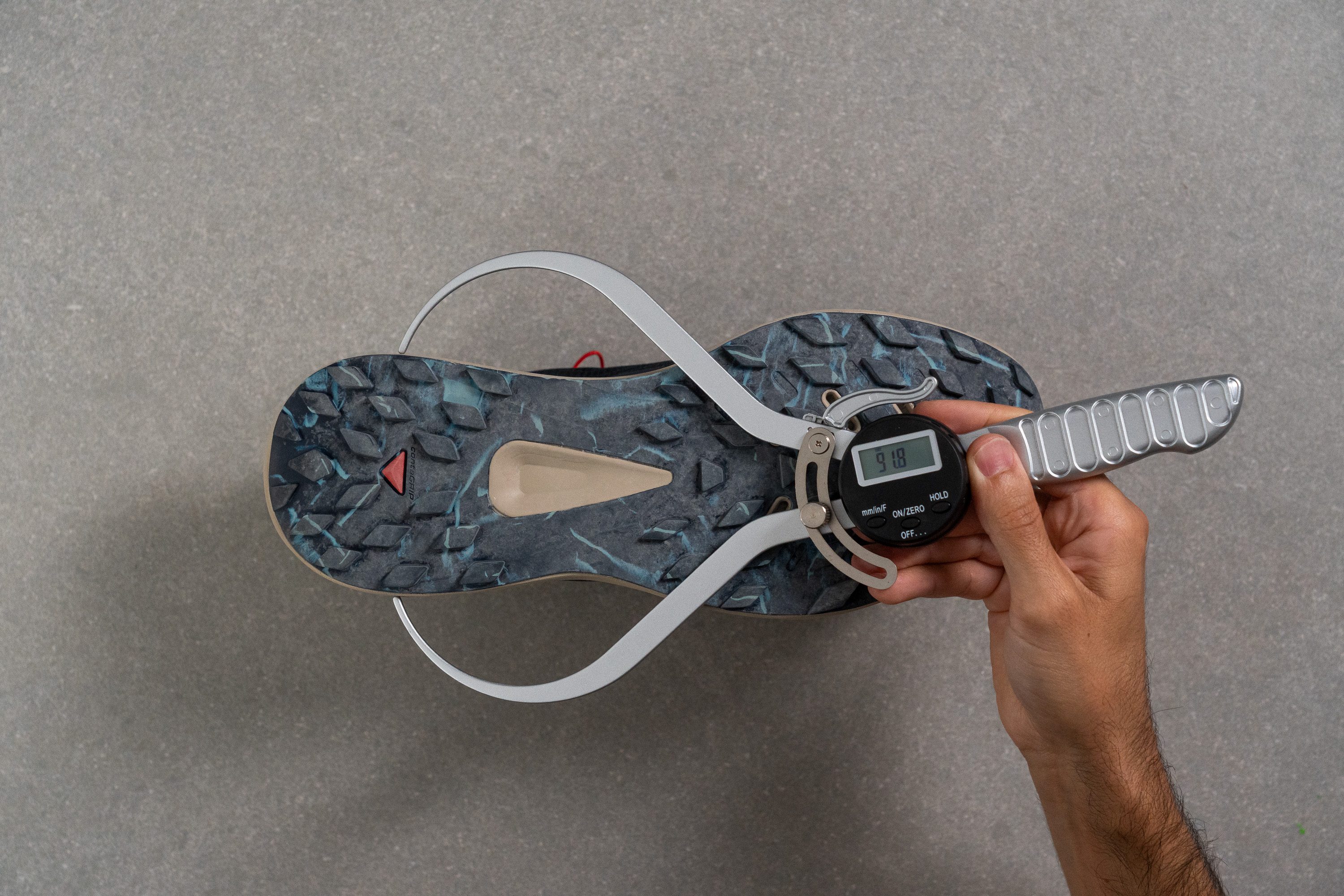
| S/Lab Ultra | 91.8 mm |
| Media | 89.8 mm |
Durabilidad
Durabilidad de la parte delantera
In our durability test, the upper’s Kevlar yarns couldn’t fully offset its ultra-thin construction, and the MATRYX fabric scored just 2/5. However, the TPU overlays on the toe cap are notably generous, offering strong protection against most impacts.
| S/Lab Ultra | 2 |
| Media | 3.1 |
Durabilidad del acolchado del talón
Fortunately, the S/Lab Ultra performed much better in our heel padding durability test, earning a solid 4/5 and easing any concerns about long-term wear.
| S/Lab Ultra | 4 |
| Media | 3 |
Durabilidad de la suela
In our outsole durability test, the Contagrip rubber performed impressively, losing only 0.8 mm of material after 18 seconds of Dremel abrasion at 10K RPM.
| S/Lab Ultra | 0.8 mm |
| Media | 0.9 mm |
Grosor de la suela
Excluding the lugs, the rubber measures just 1.3 mm thick, which is nearly half the average. Still, we find this perfectly acceptable considering the racing-oriented design of the S/Lab series.
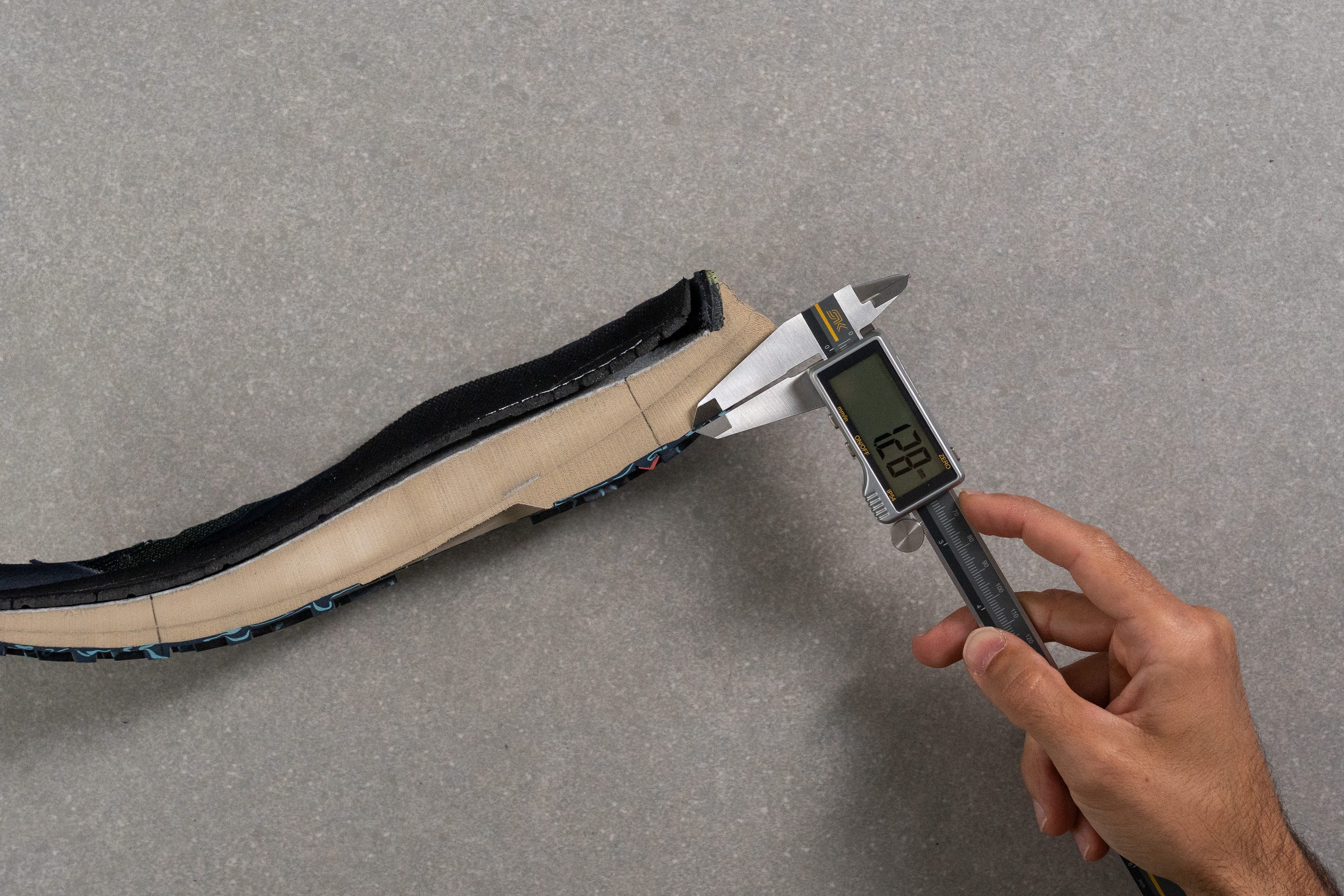
| S/Lab Ultra | 1.3 mm |
| Media | 2.2 mm |
Varios
Grosor de la plantilla
Salomon often opts for thinner insoles than the average running shoe, and the S/Lab Ultra confirms it once again with its slim 3.8 mm insert.
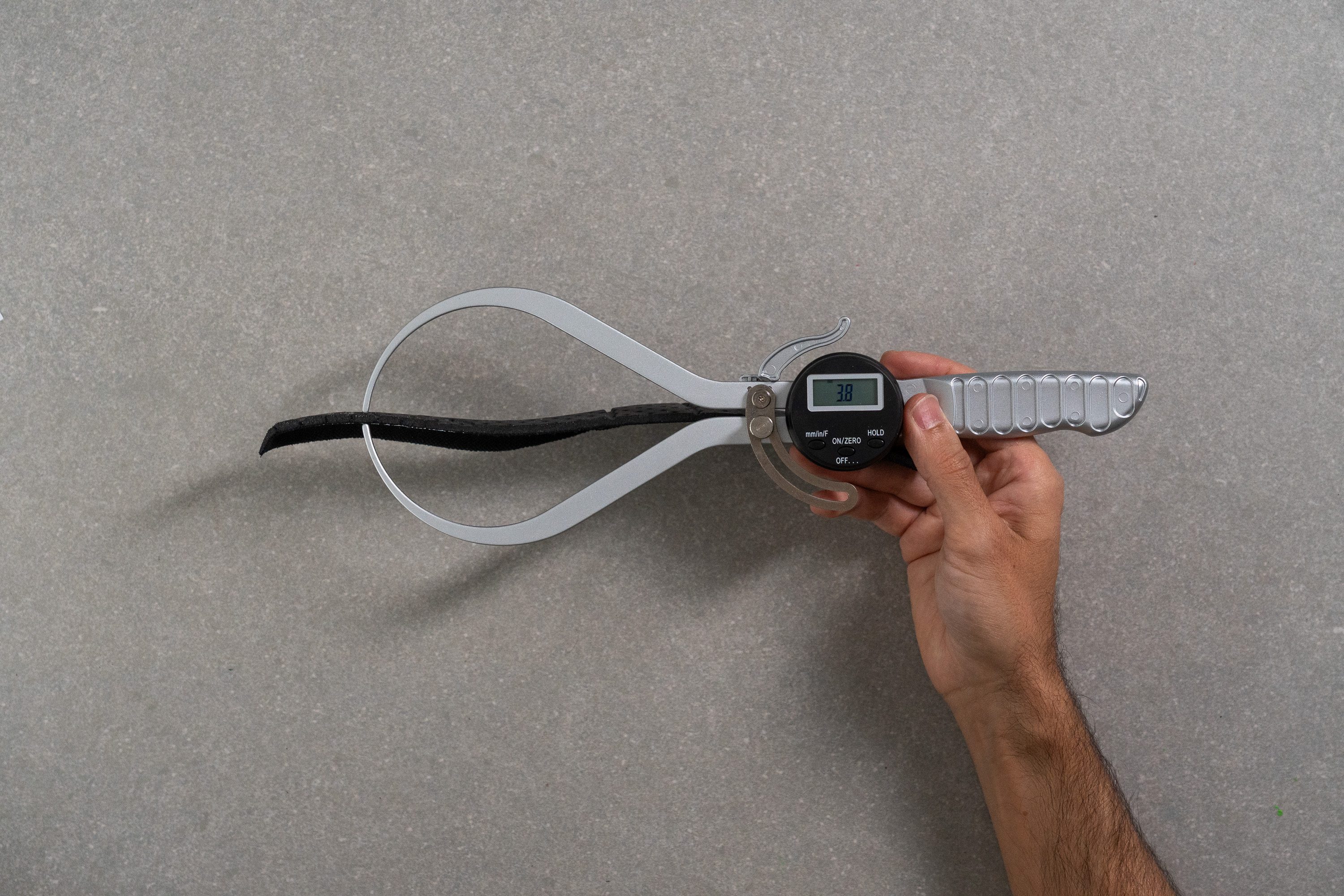
| S/Lab Ultra | 3.8 mm |
| Media | 4.7 mm |
Plantilla extraíble
The standard insole can be easily replaced with a custom one if preferred. However, the one included with the shoe is perforated for better ventilation, and you’d lose that benefit.
| S/Lab Ultra | Sí |
Rigidez de la mediasuela en frío (%)
The foam in this shoe isn’t plain EVA, it’s a blend of EVA and Olefin, which helps it stay more resilient in cold conditions. However, in our lab test, it showed an average performance with a 29% change.
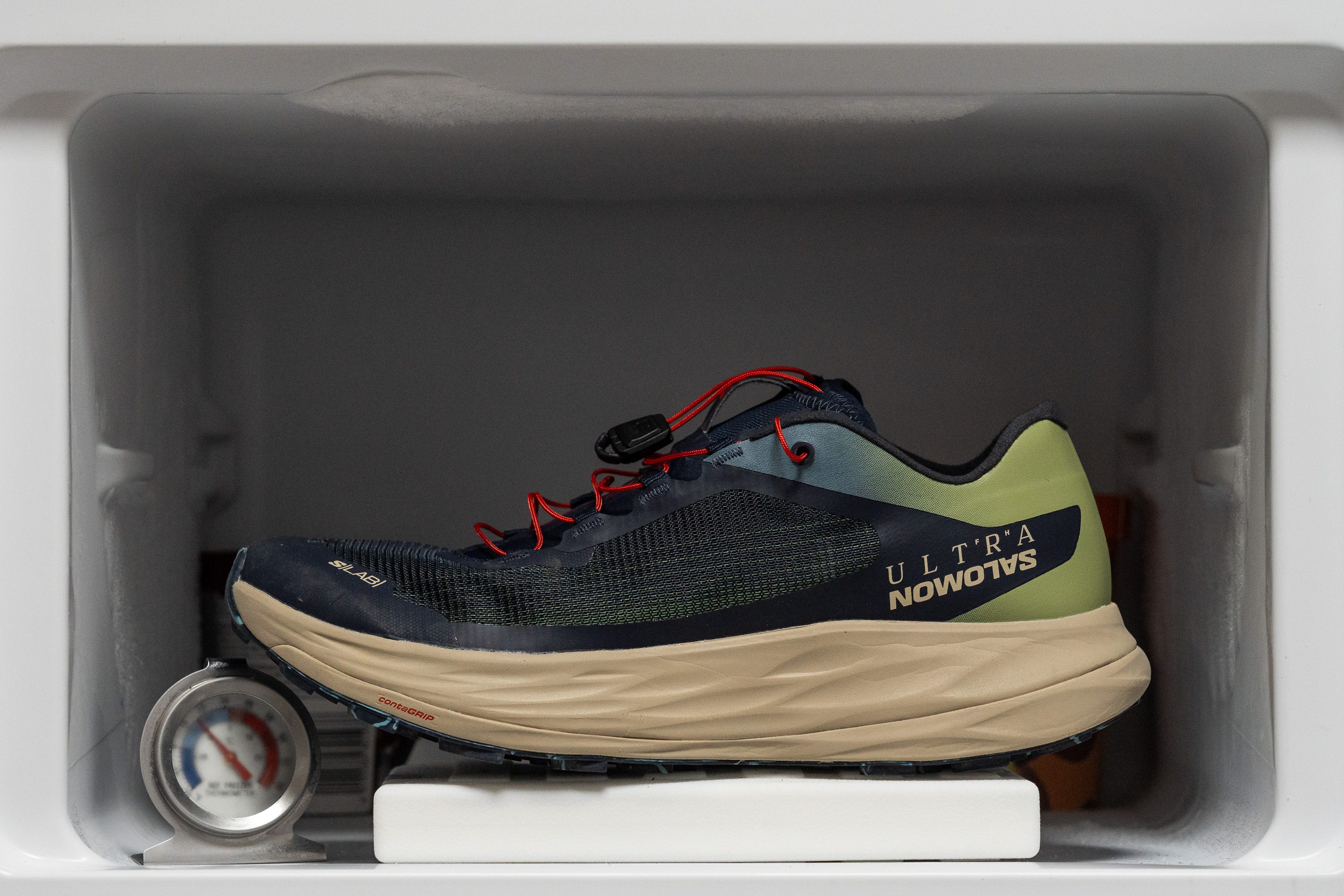
| S/Lab Ultra | 29% |
| Media | 26% |
Elementos reflectantes
For such a high price tag, it would’ve been great to see some reflective elements included. After all, if this shoe is built for ultra races, many of those take runners through the night.
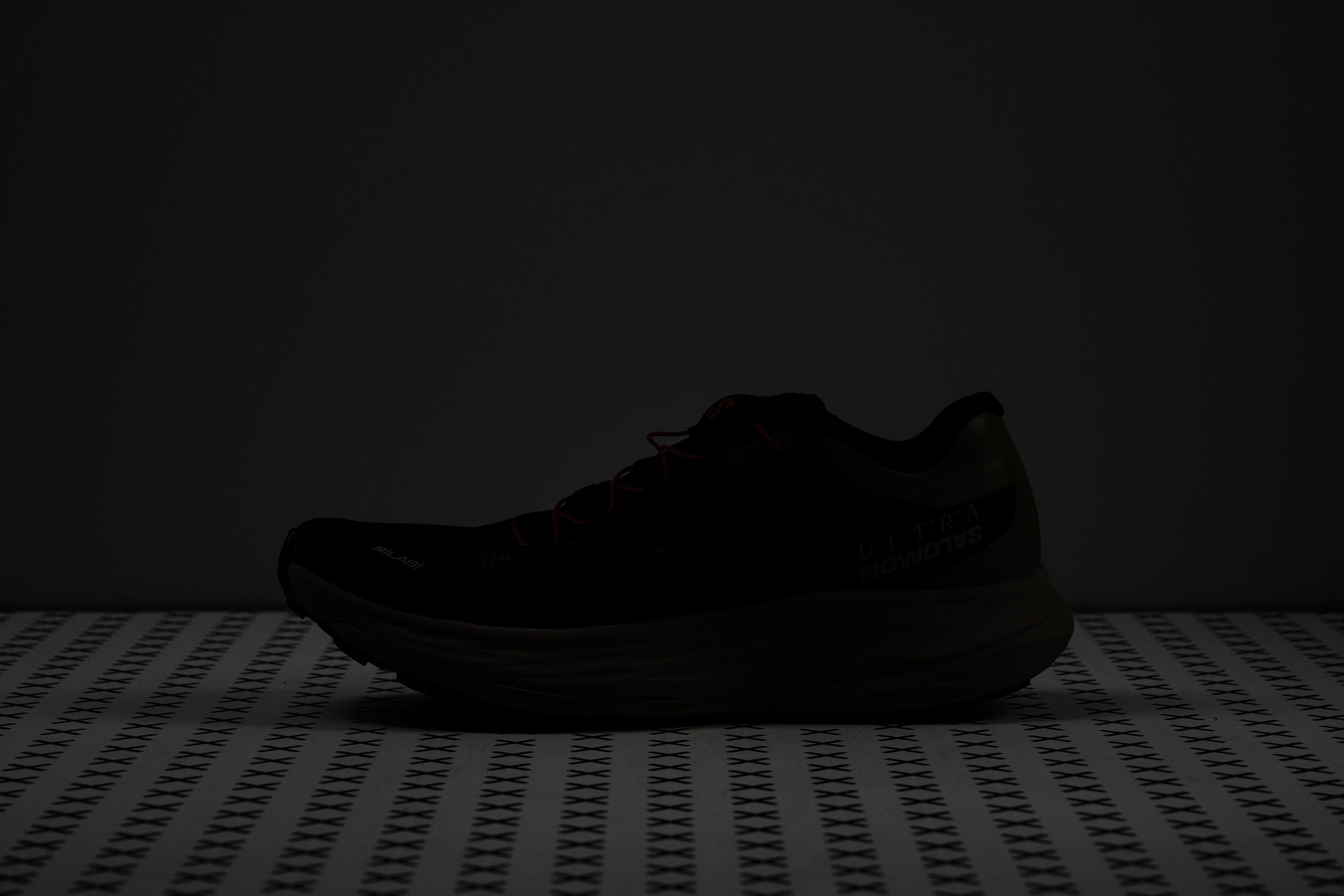
| S/Lab Ultra | No |
Acolchado de la lengüeta
The tongue is very well designed for ultra-distance runs. Measuring 5.5 mm, it avoids excessive thickness that could feel restrictive while still providing enough padding to keep the instep comfortable during day-long efforts.
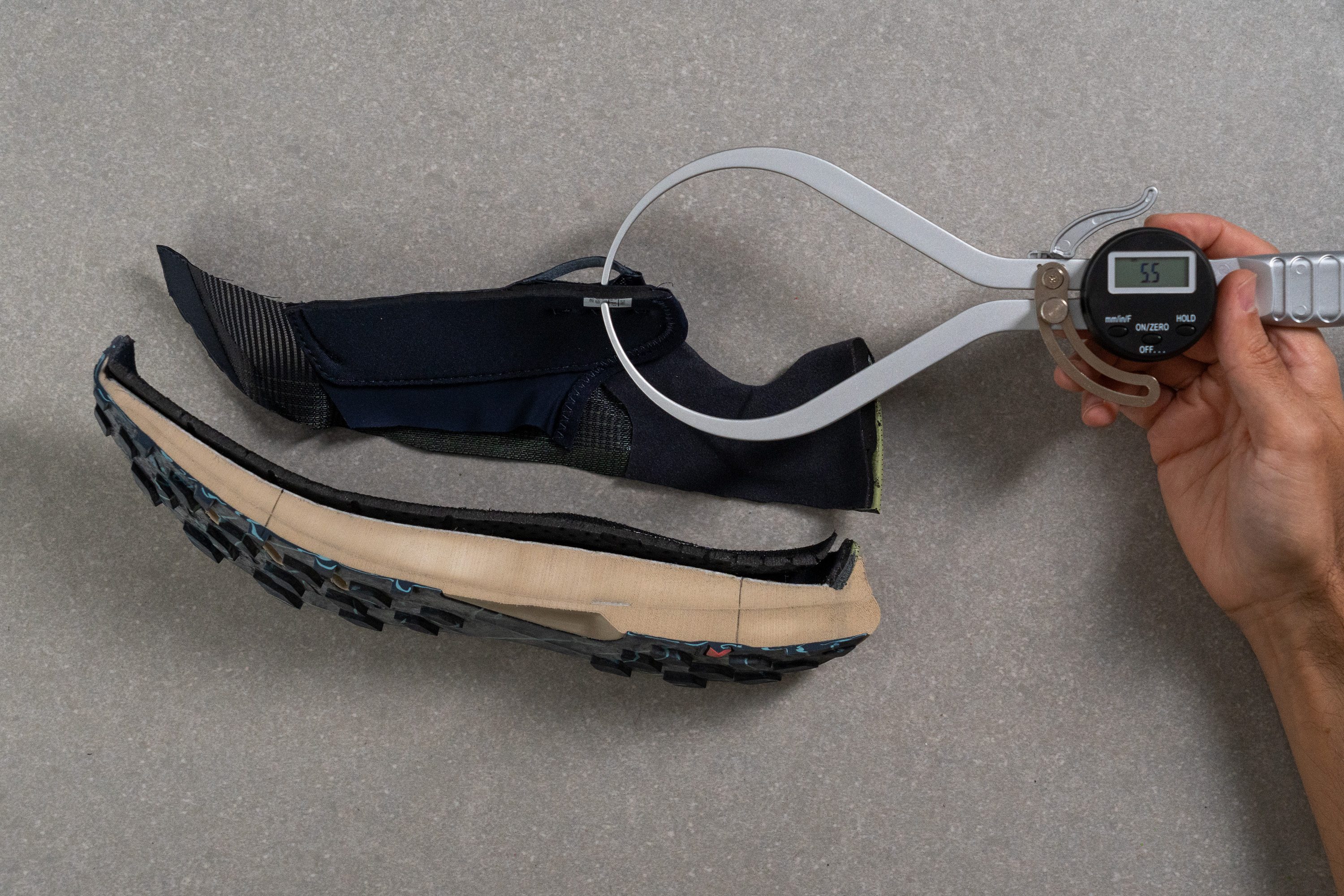
| S/Lab Ultra | 5.5 mm |
| Media | 6.4 mm |
Lengüeta: tipo de refuerzo
The tongue features an excellent gusseted design that enhances lockdown while keeping debris out of the shoe’s interior. That's exactly what you’d expect from a premium trail model.
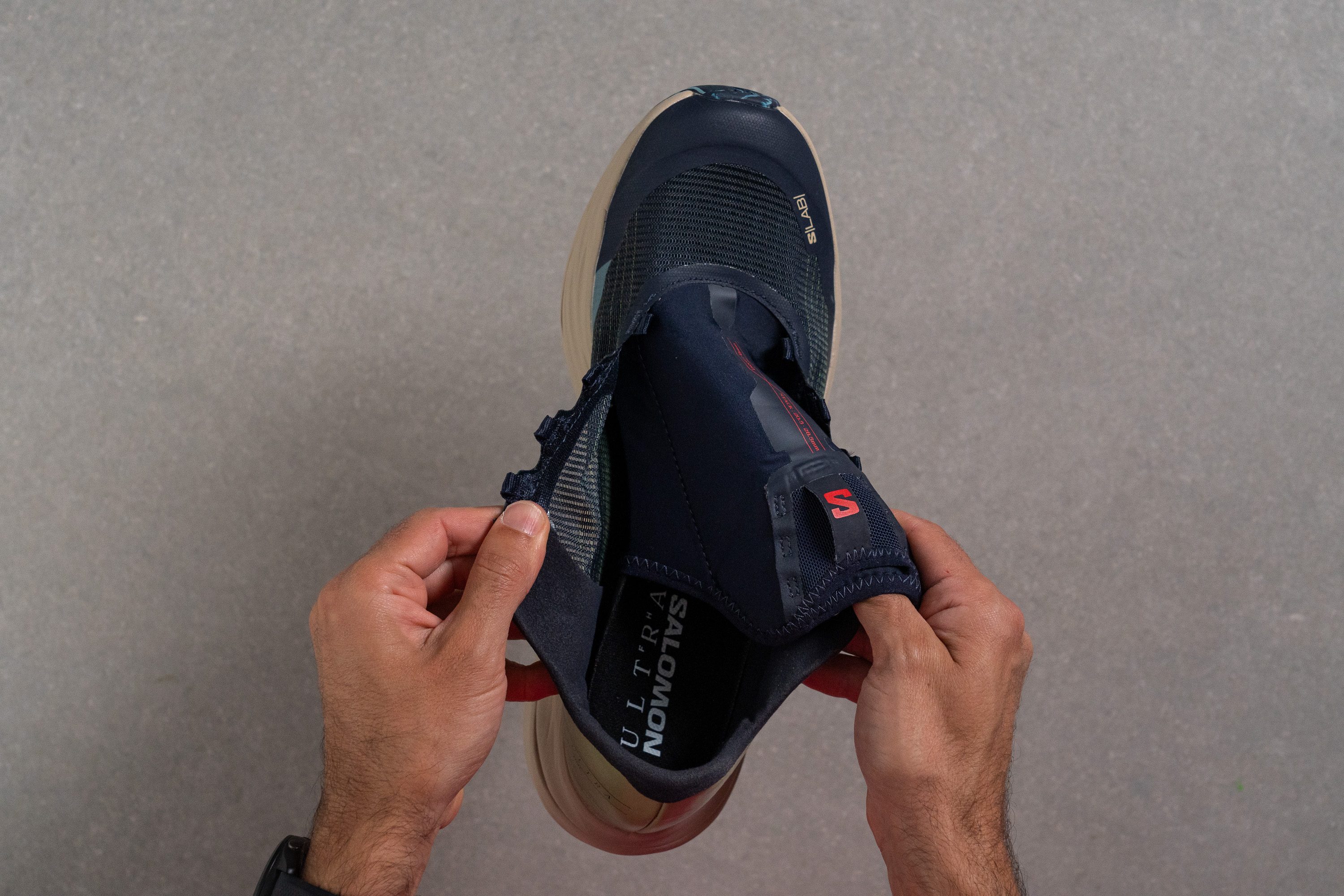
| S/Lab Ultra | Ambos lados (completo) |
Precio
Was it the chicken or the egg? In this case, is it the energy return or the price? Either the shoe lacks bounce for what it costs, or it costs too much for the bounce it offers. When both are considered, it’s clearly pricier (or less lively) than it should be.
| S/Lab Ultra | $240 |
Tirador del talón
The heel design showcases a minimalist construction with no heel tab, emphasizing a streamlined design.
The "François x Salomon" inscription is cool and highlights the long-standing collaboration between Salomon and François D’Haene, celebrating a long partnership that has been really successful for both!
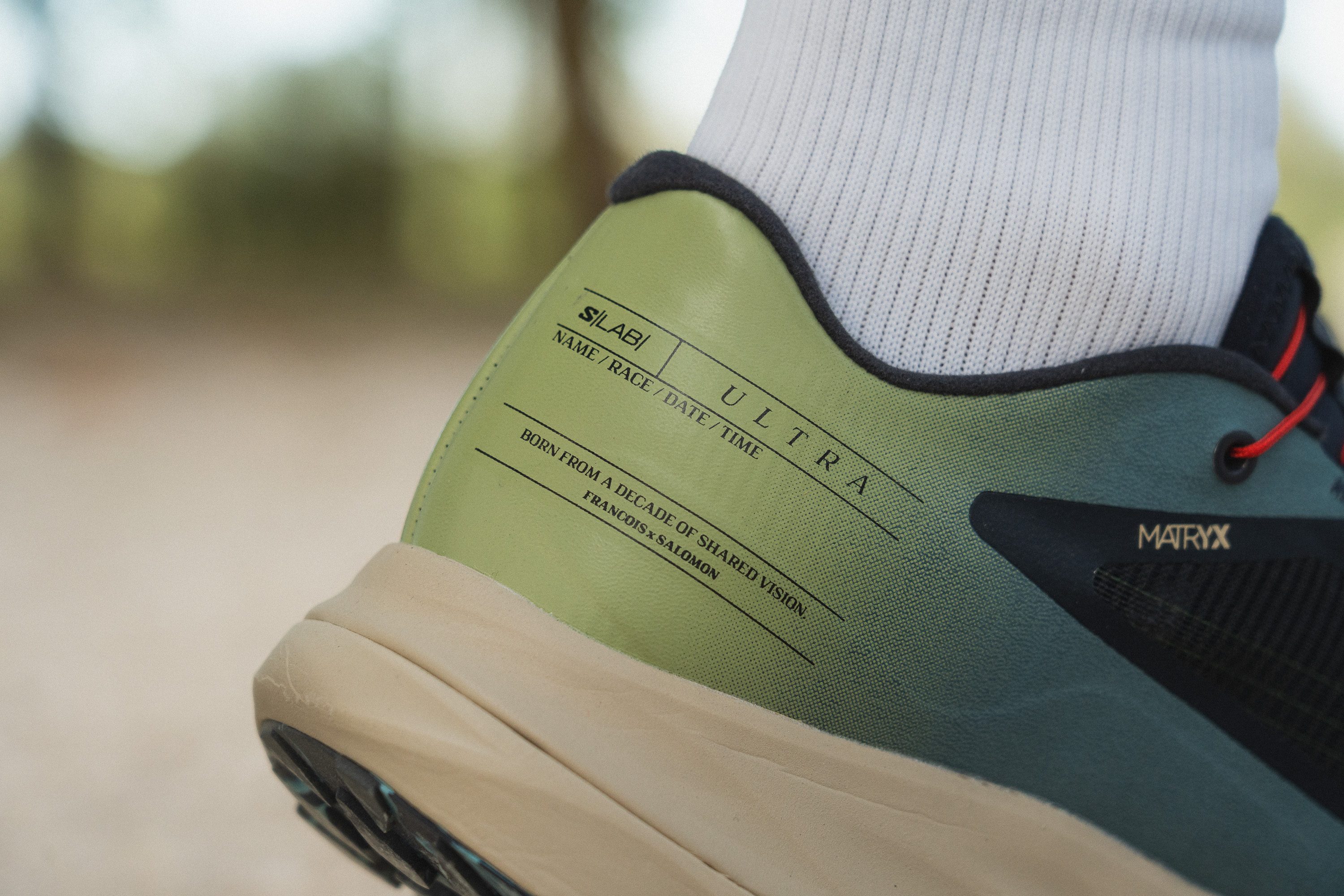
| S/Lab Ultra | Ninguno |
Quicklace
We tested the QuickLace system and found it performed exactly as expected from every other Salomon model—smooth, reliable, and blazing fast to adjust. The precision-tightening setup delivers a secure fit that feels both quick and intuitive.
And we also appreciated the lace garage, neatly built into the tongue.

